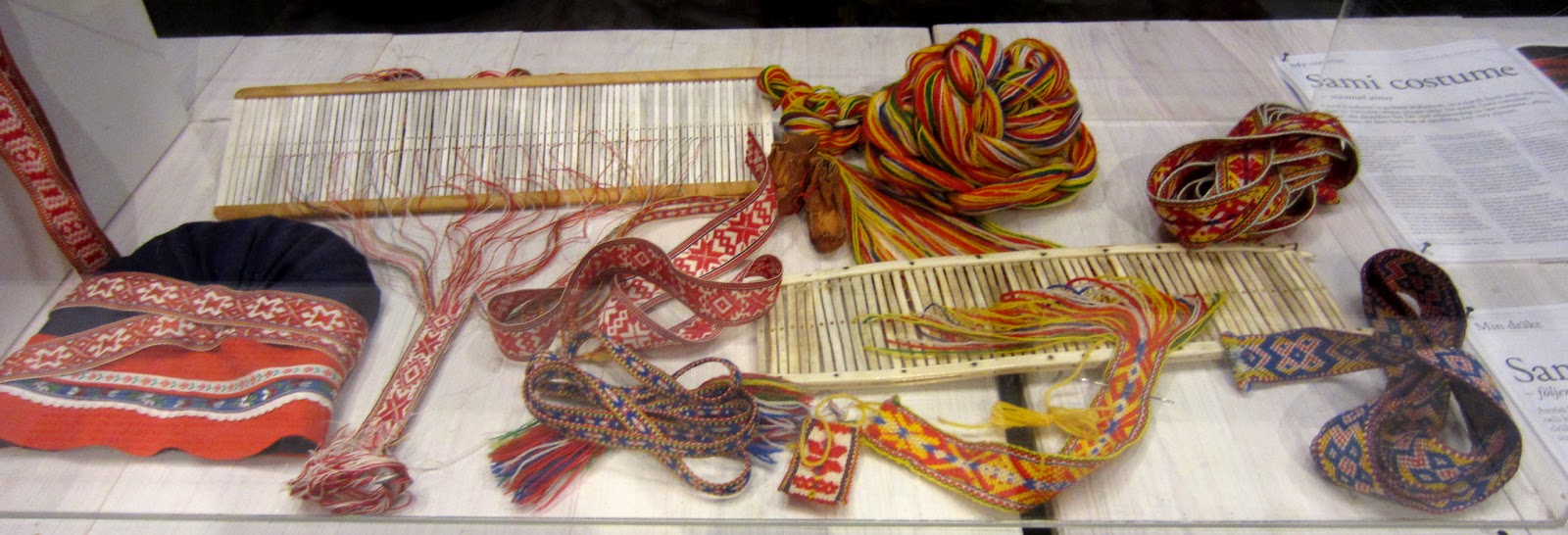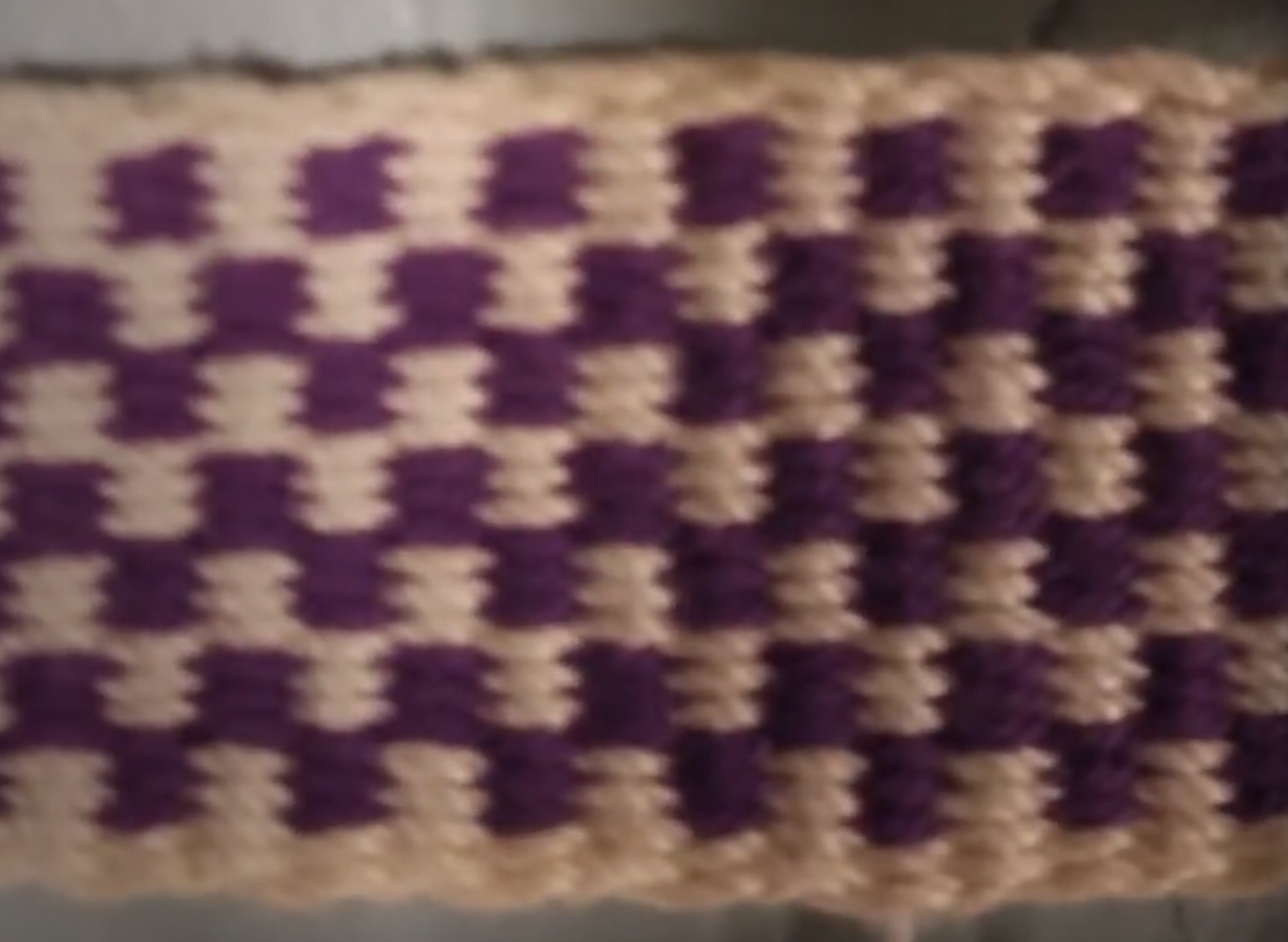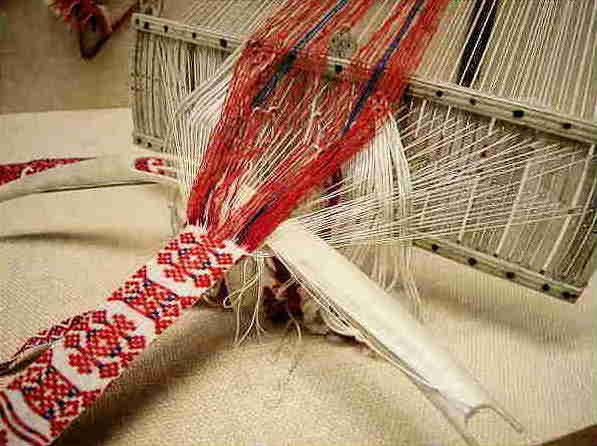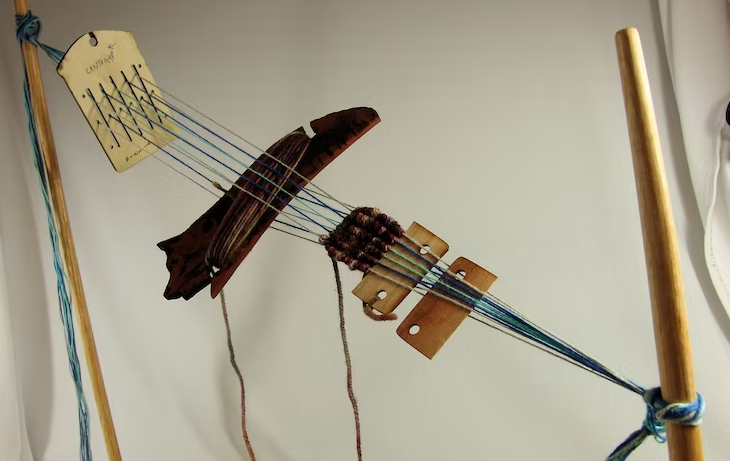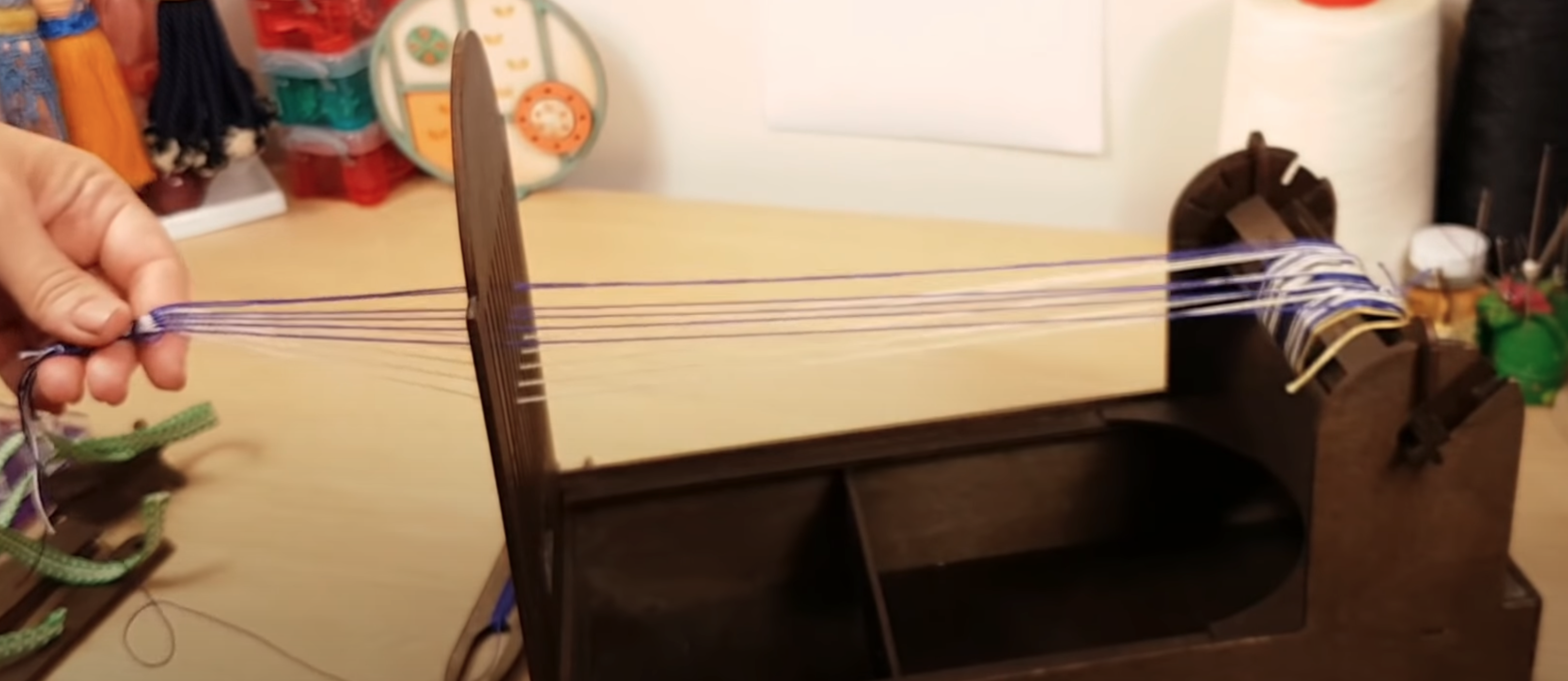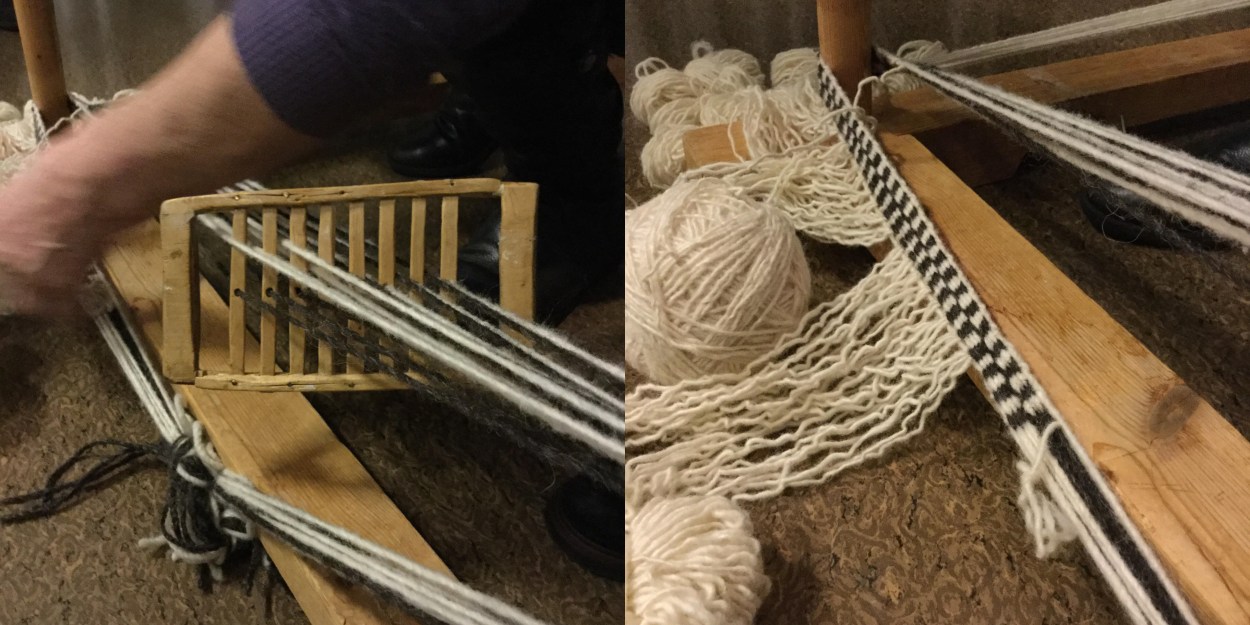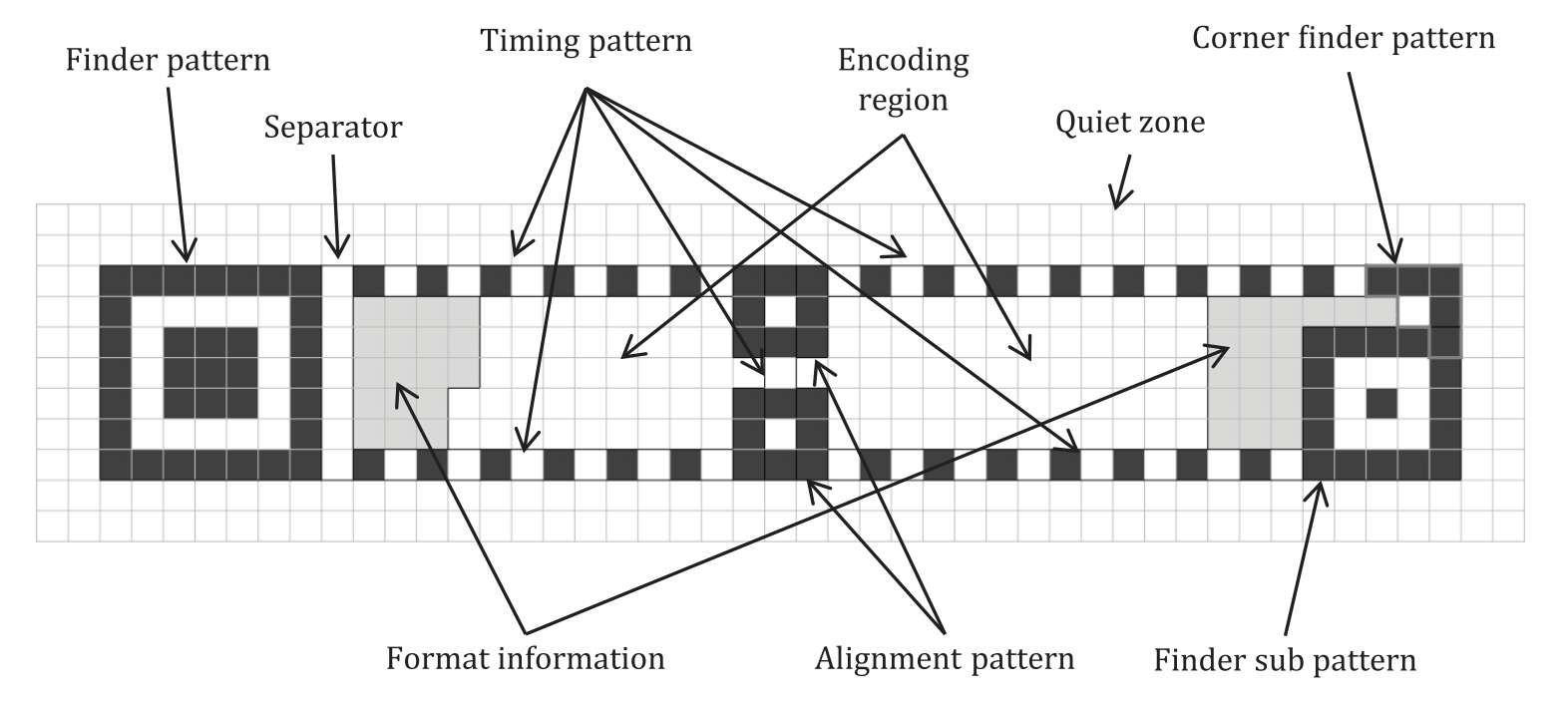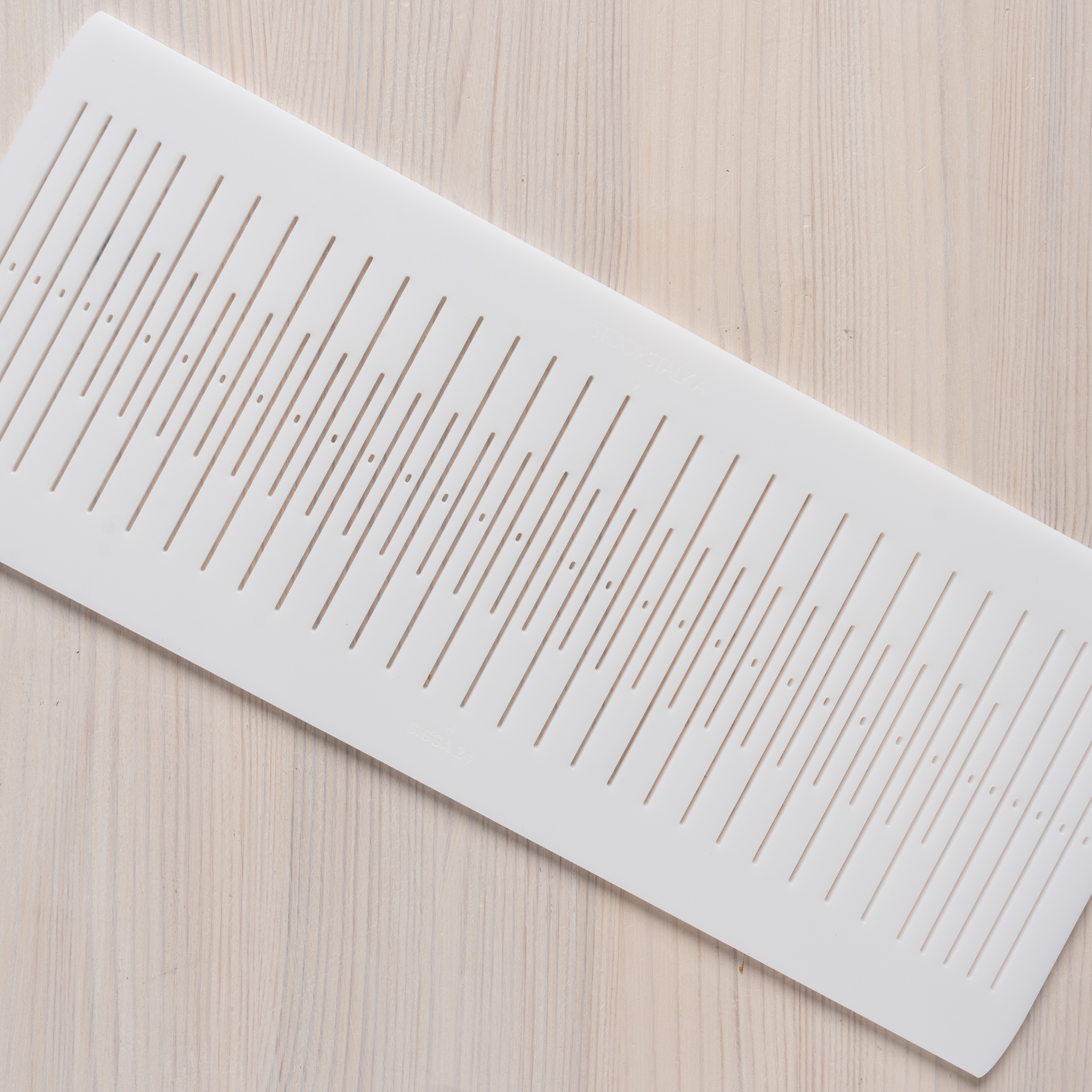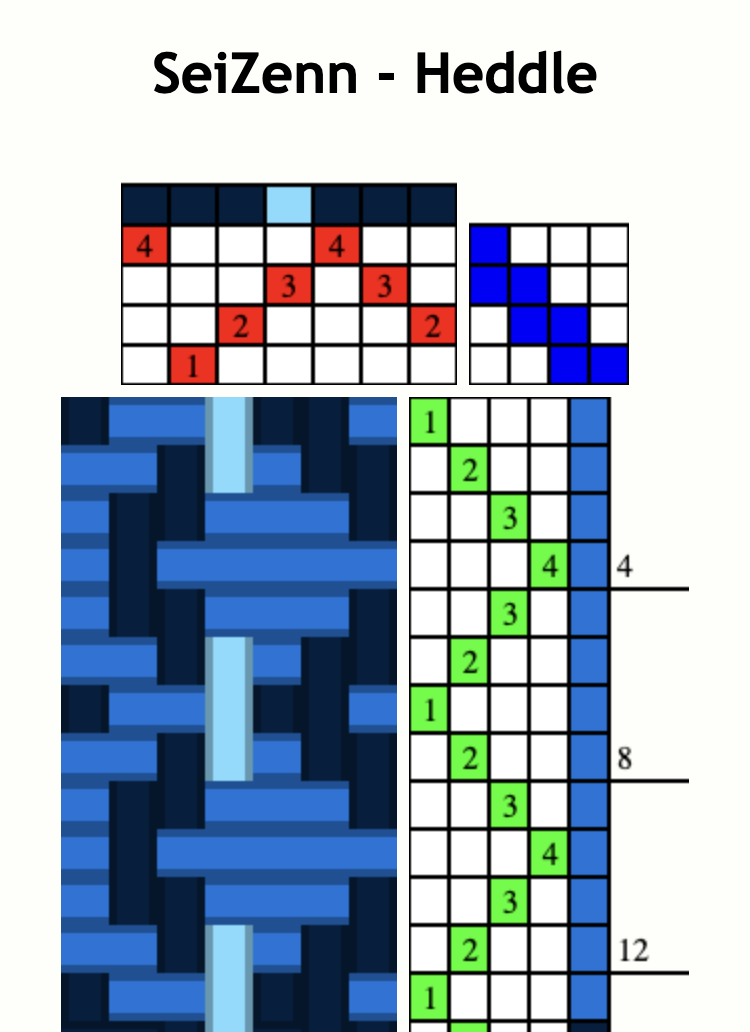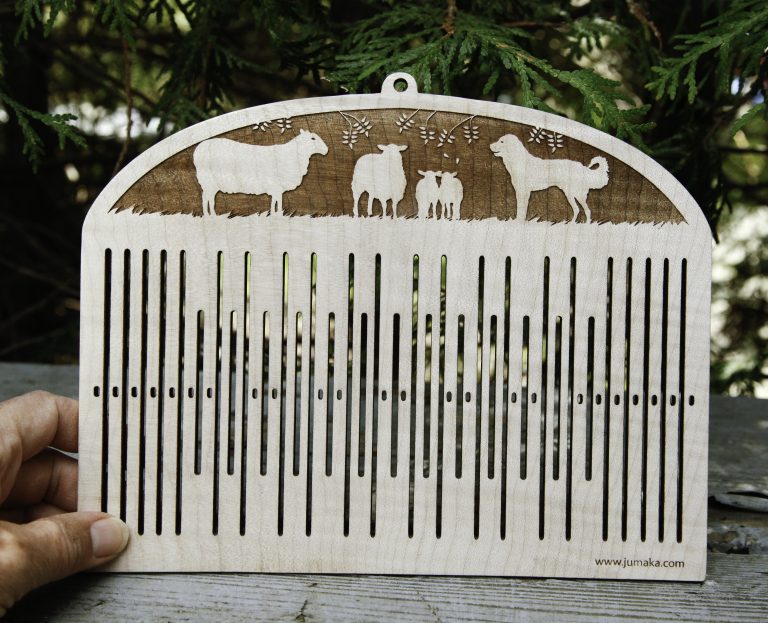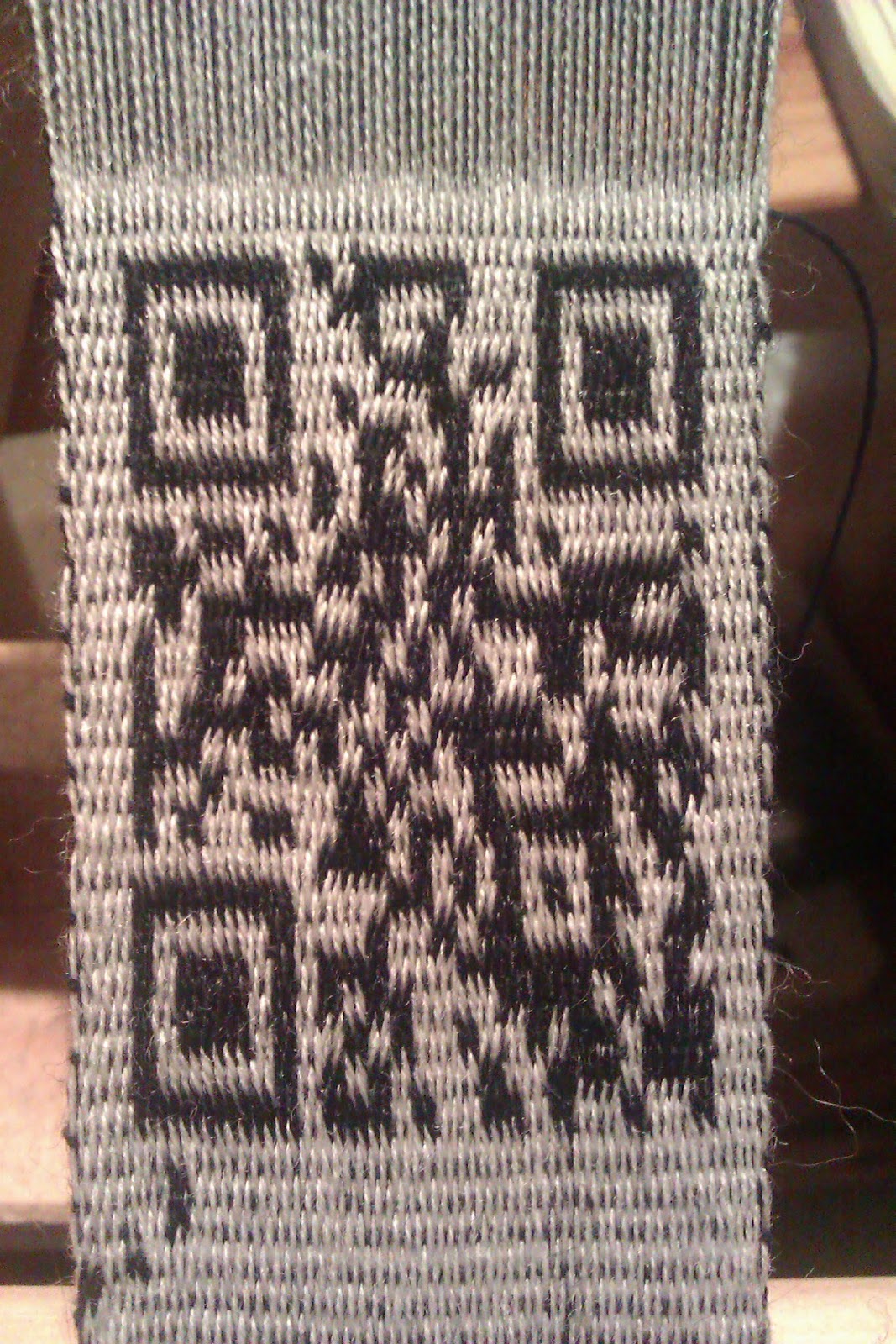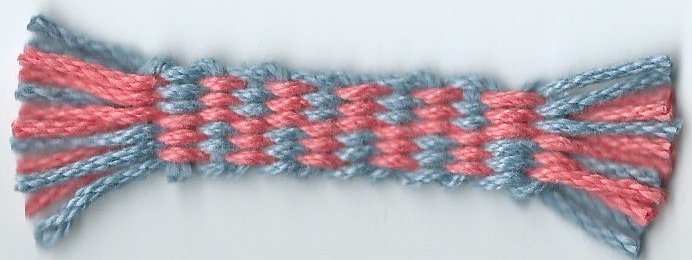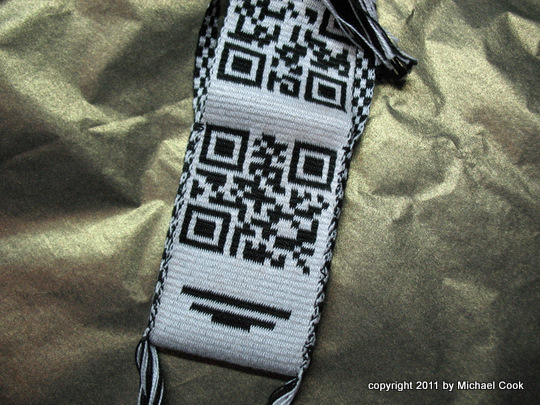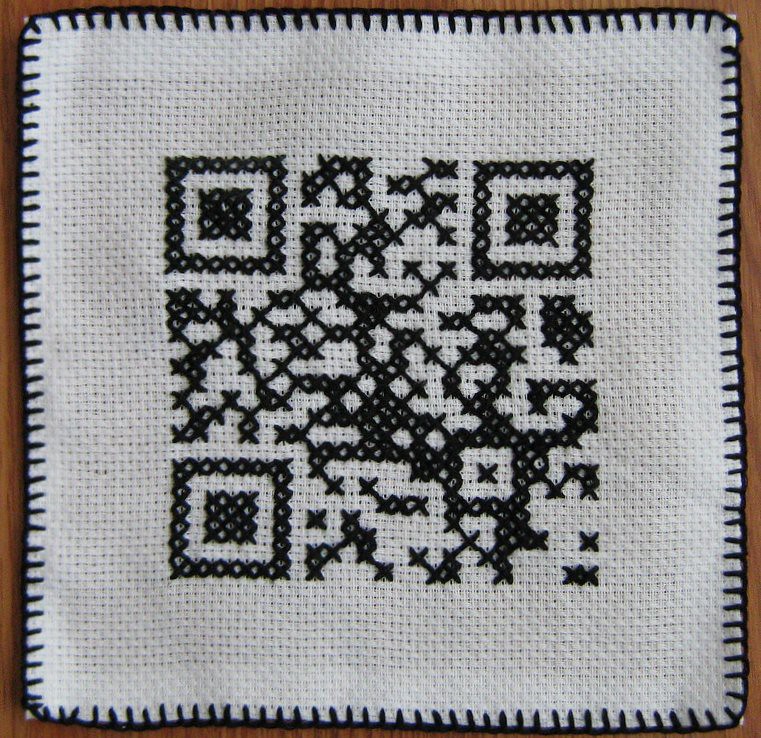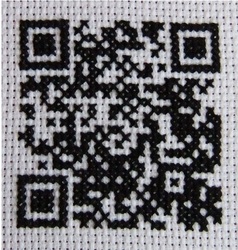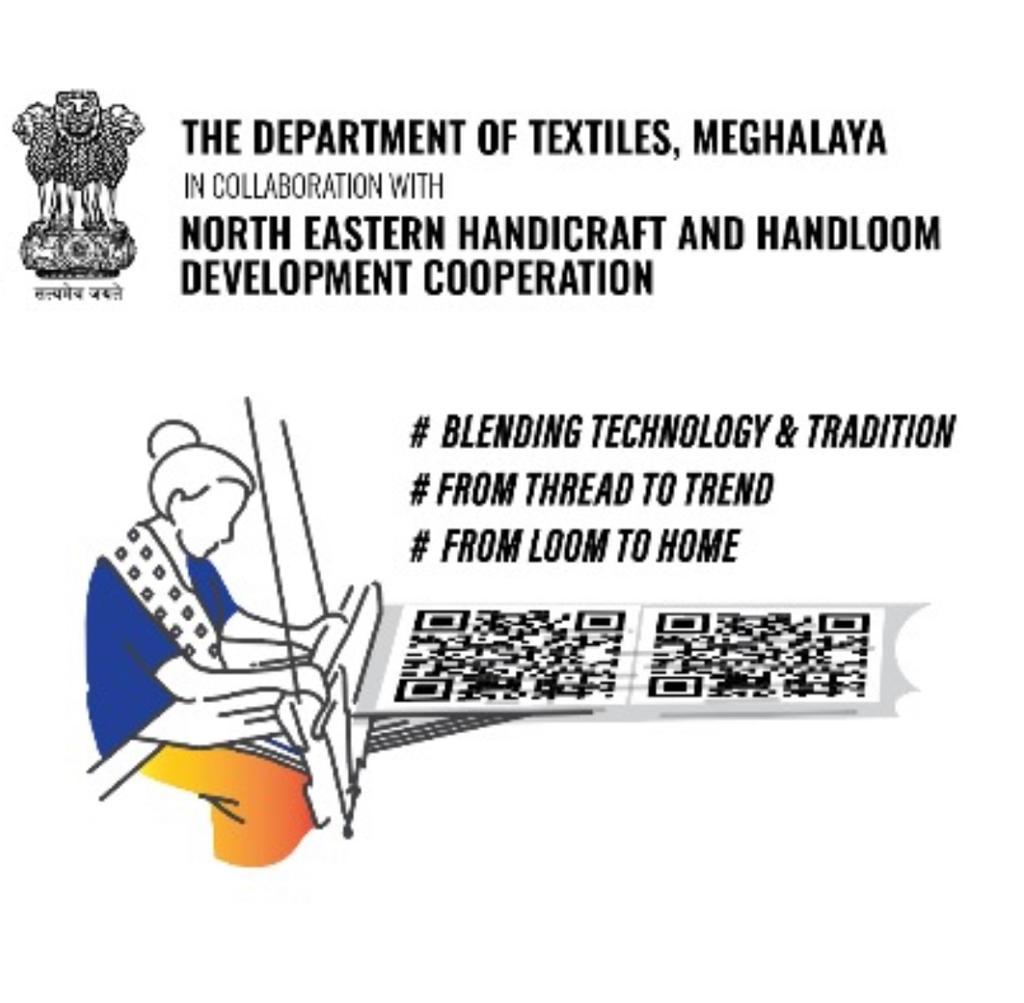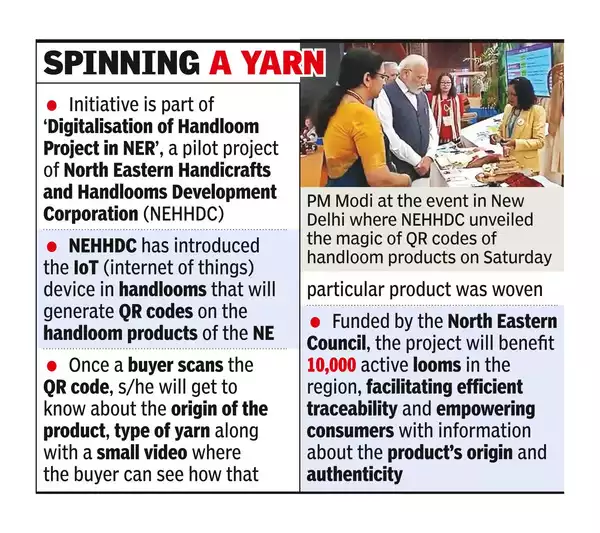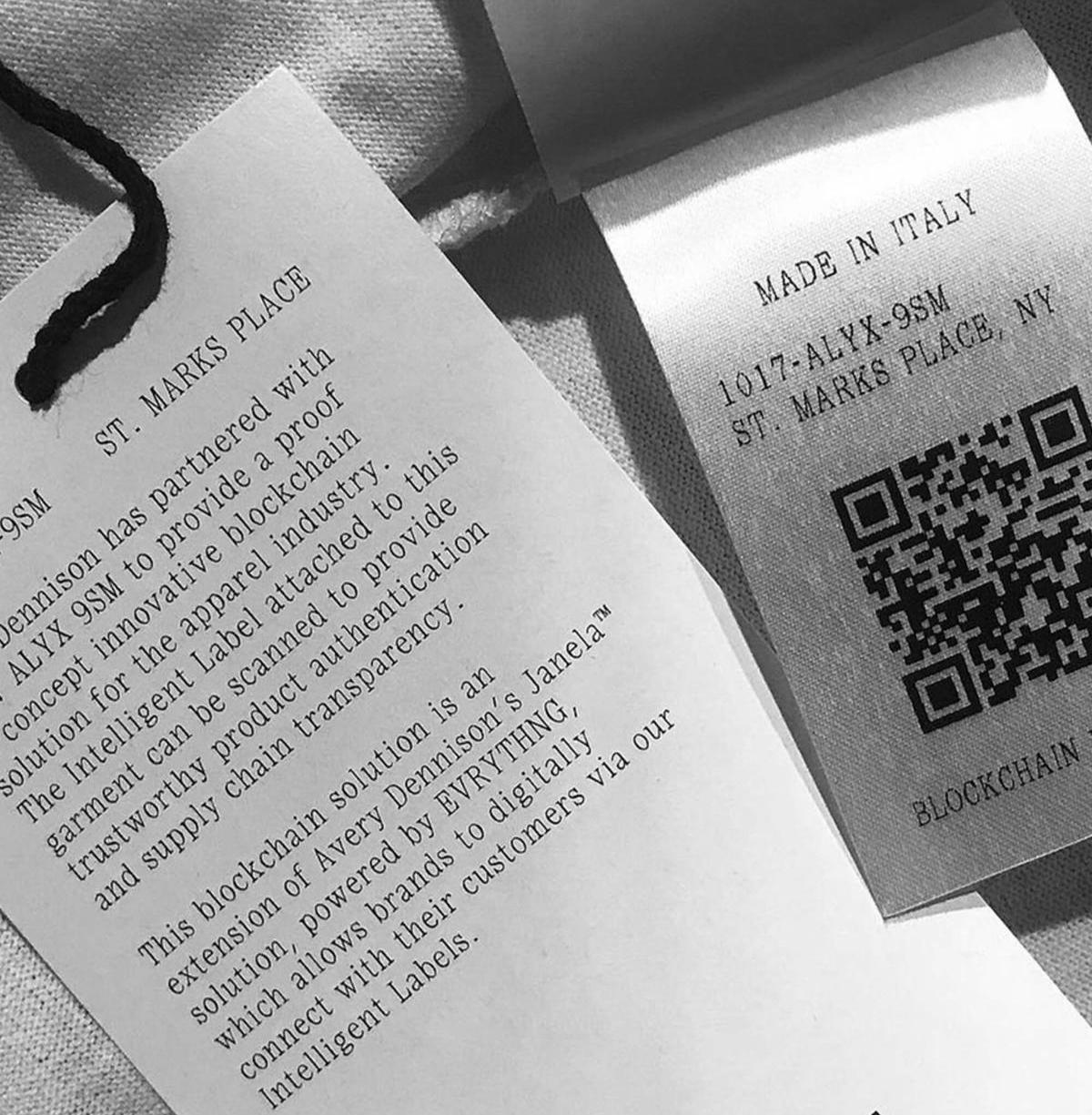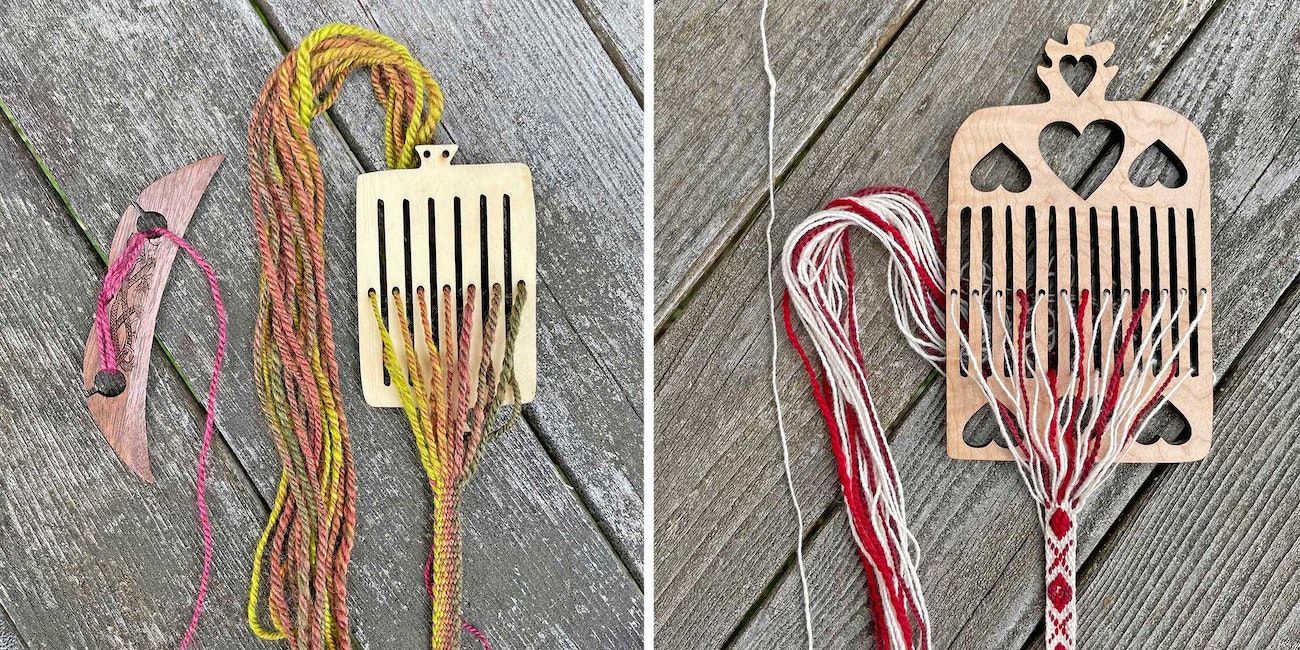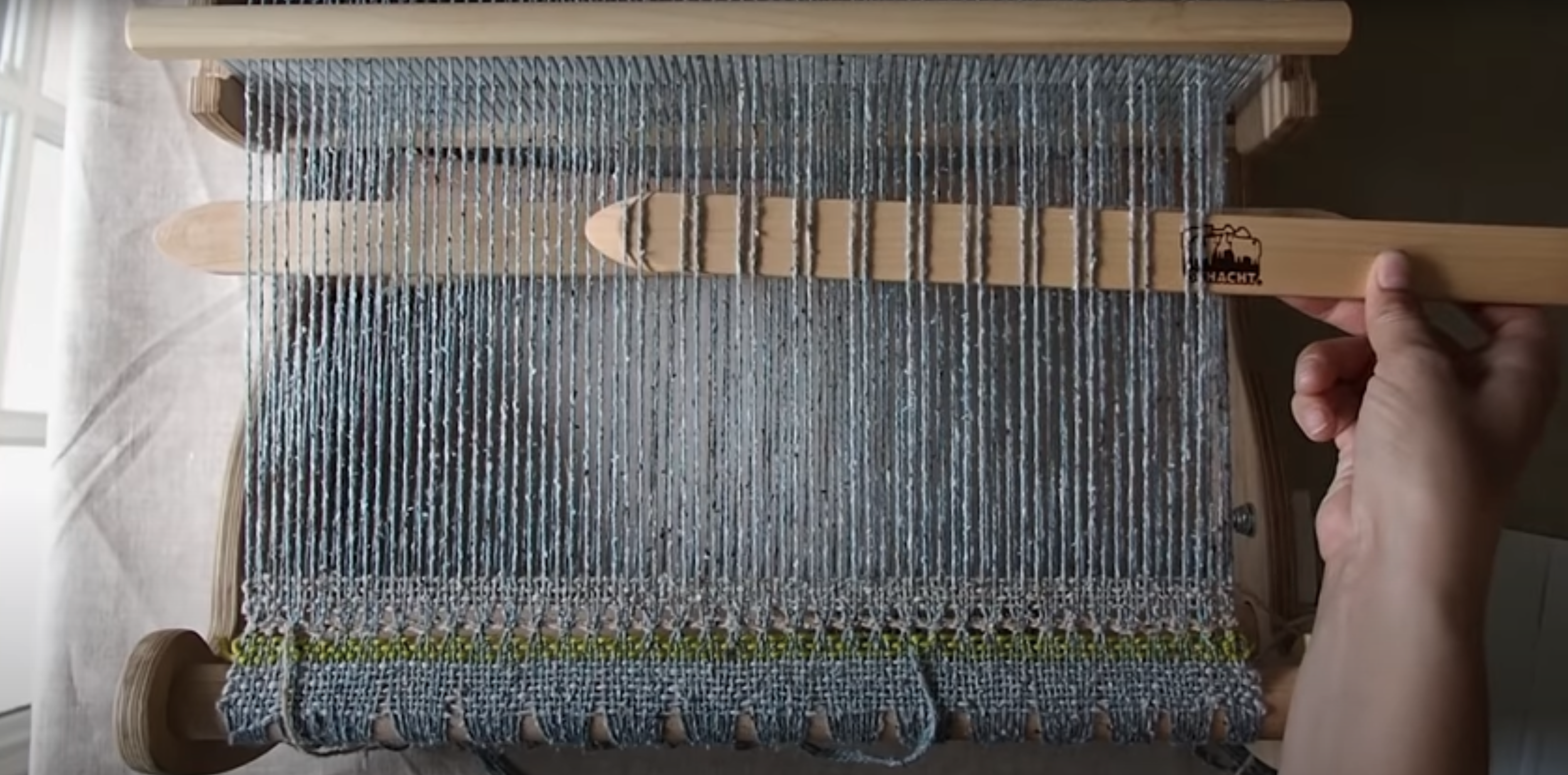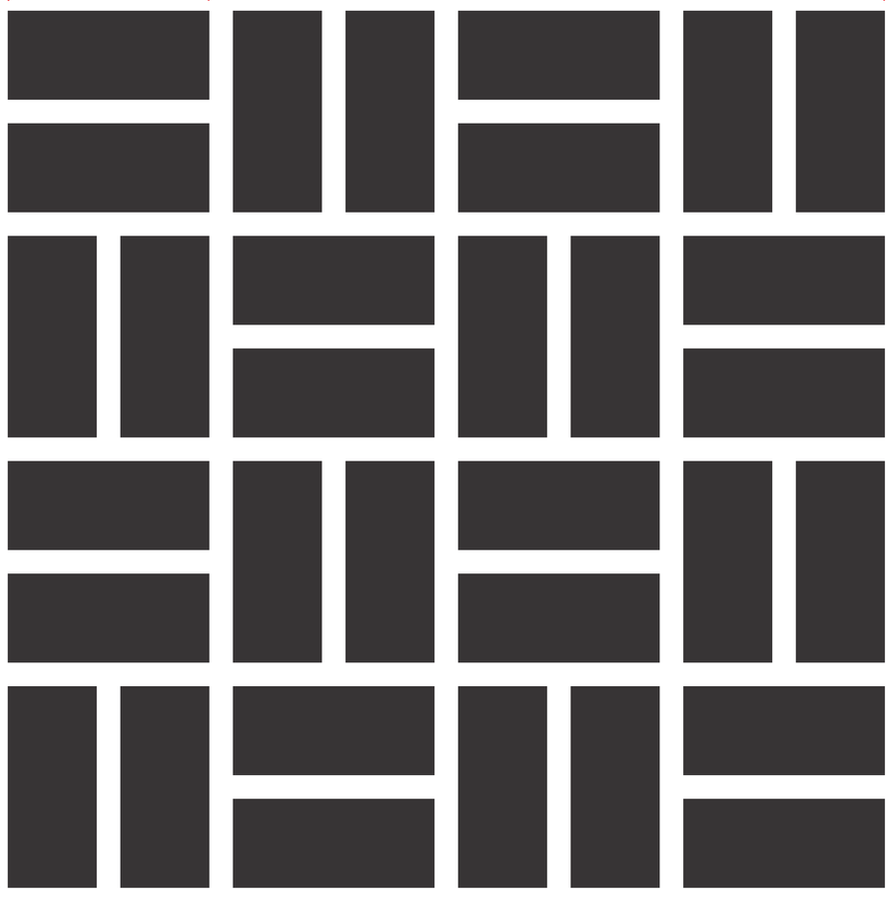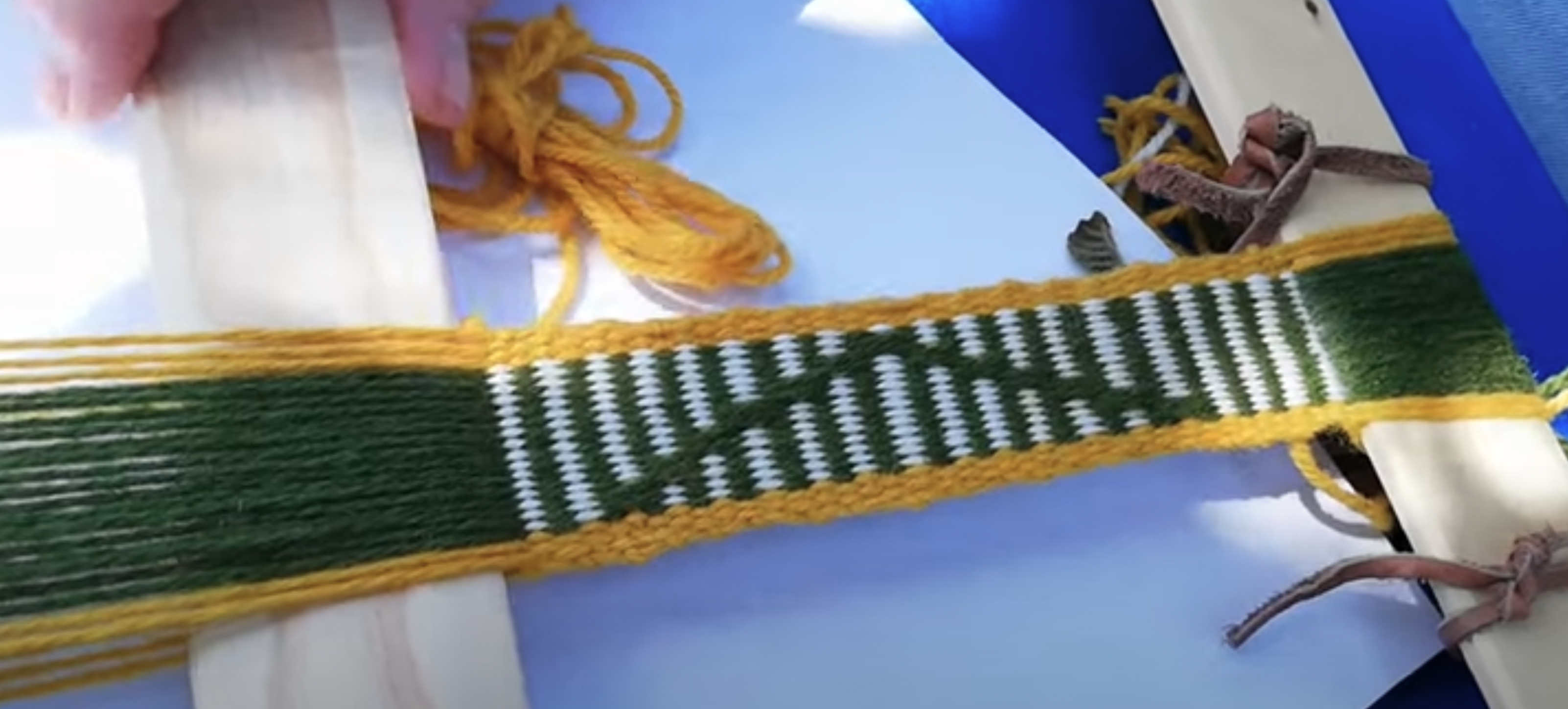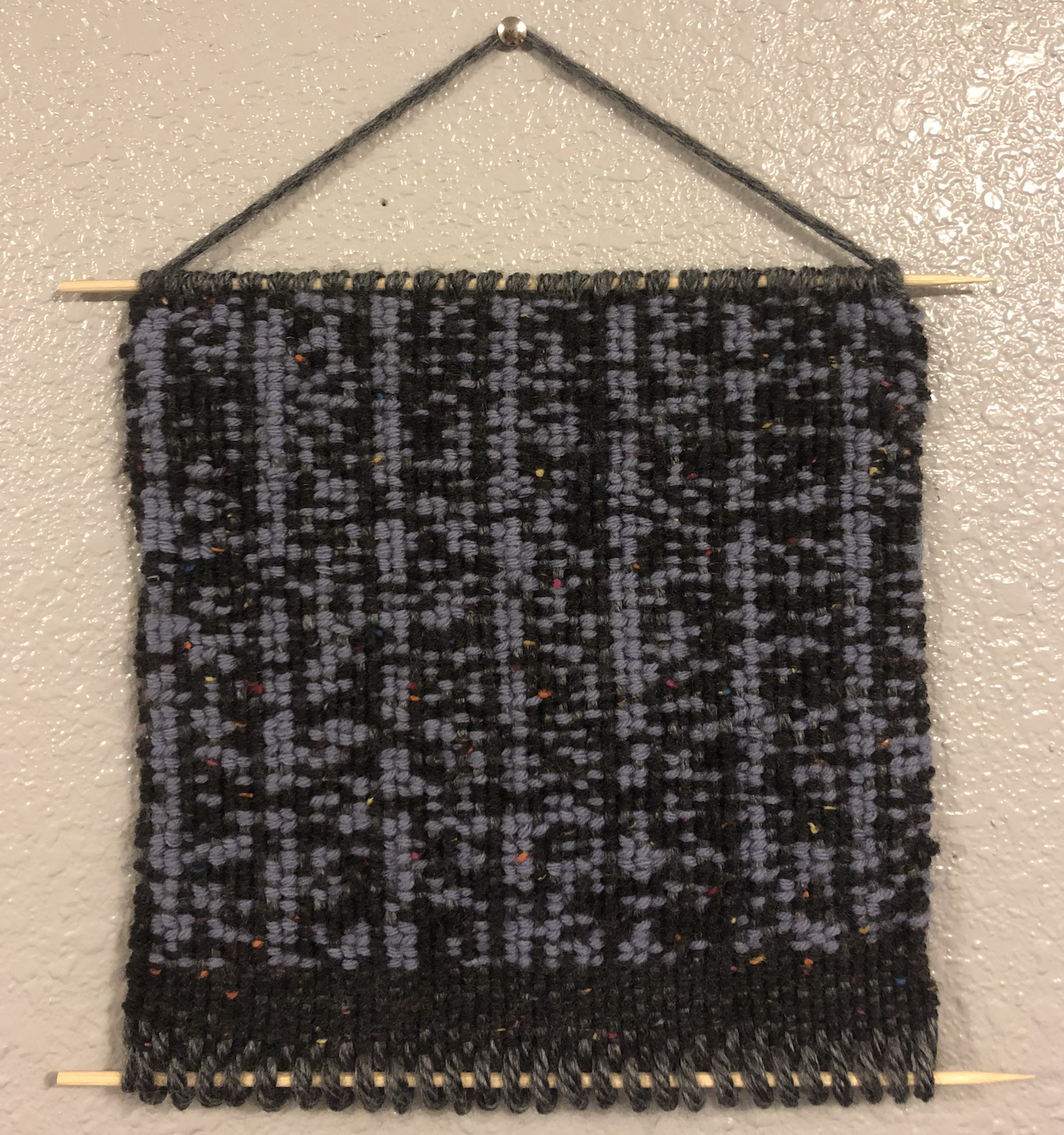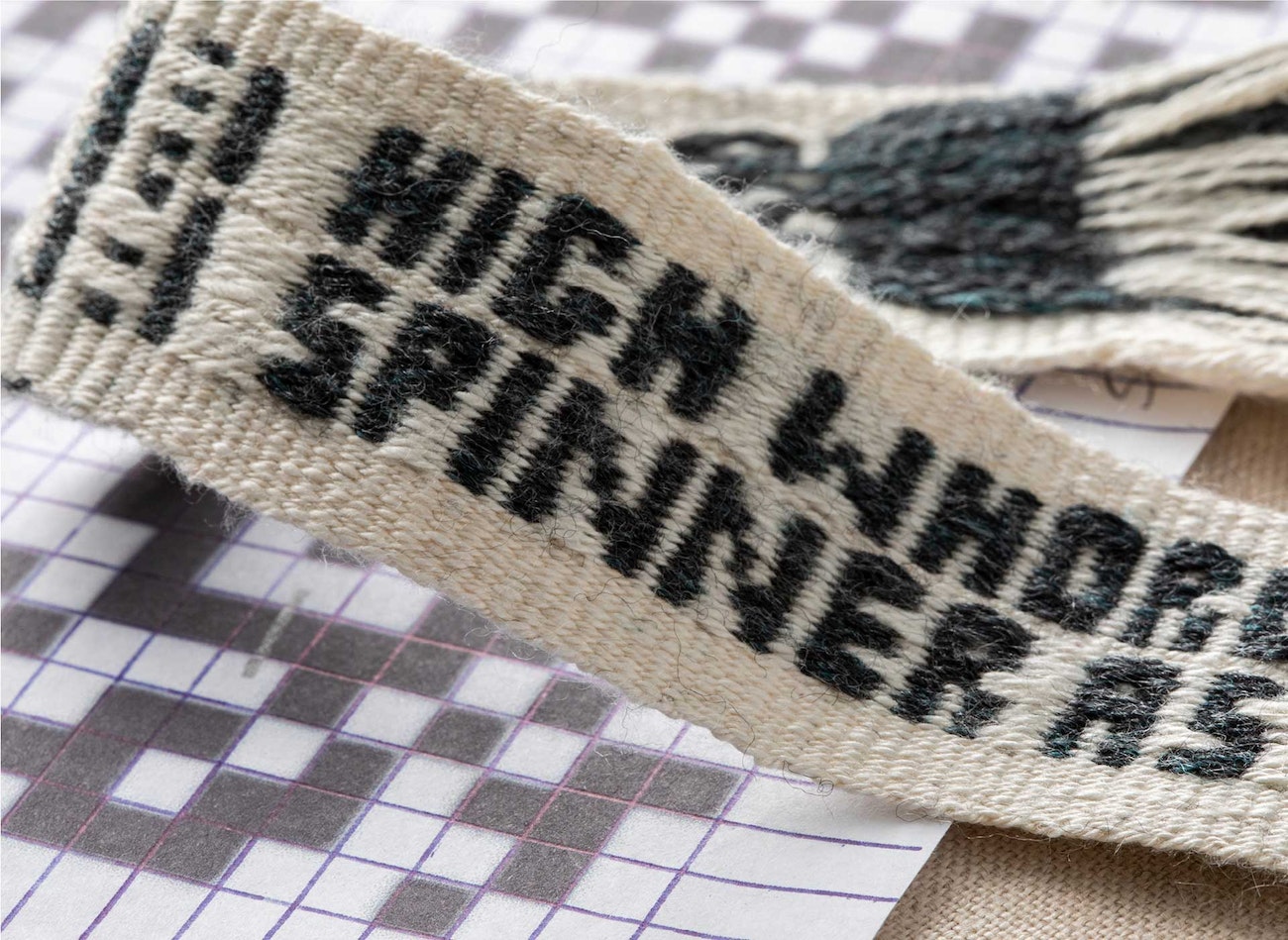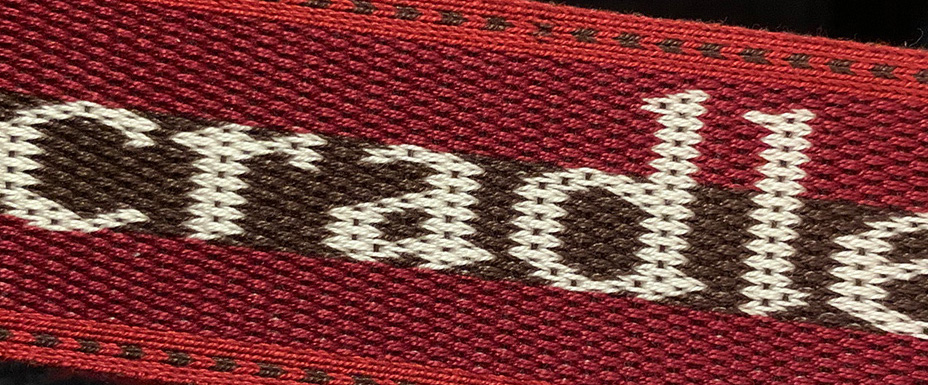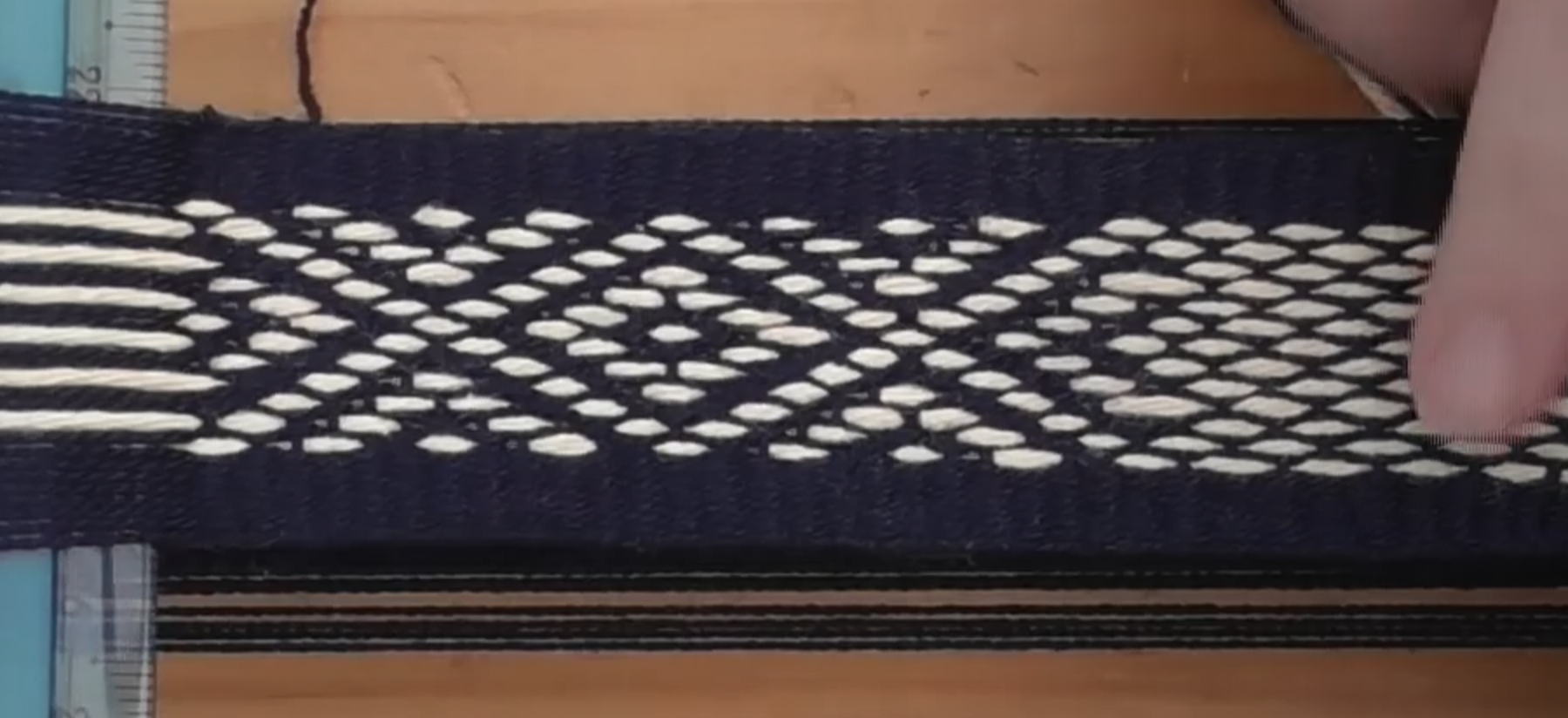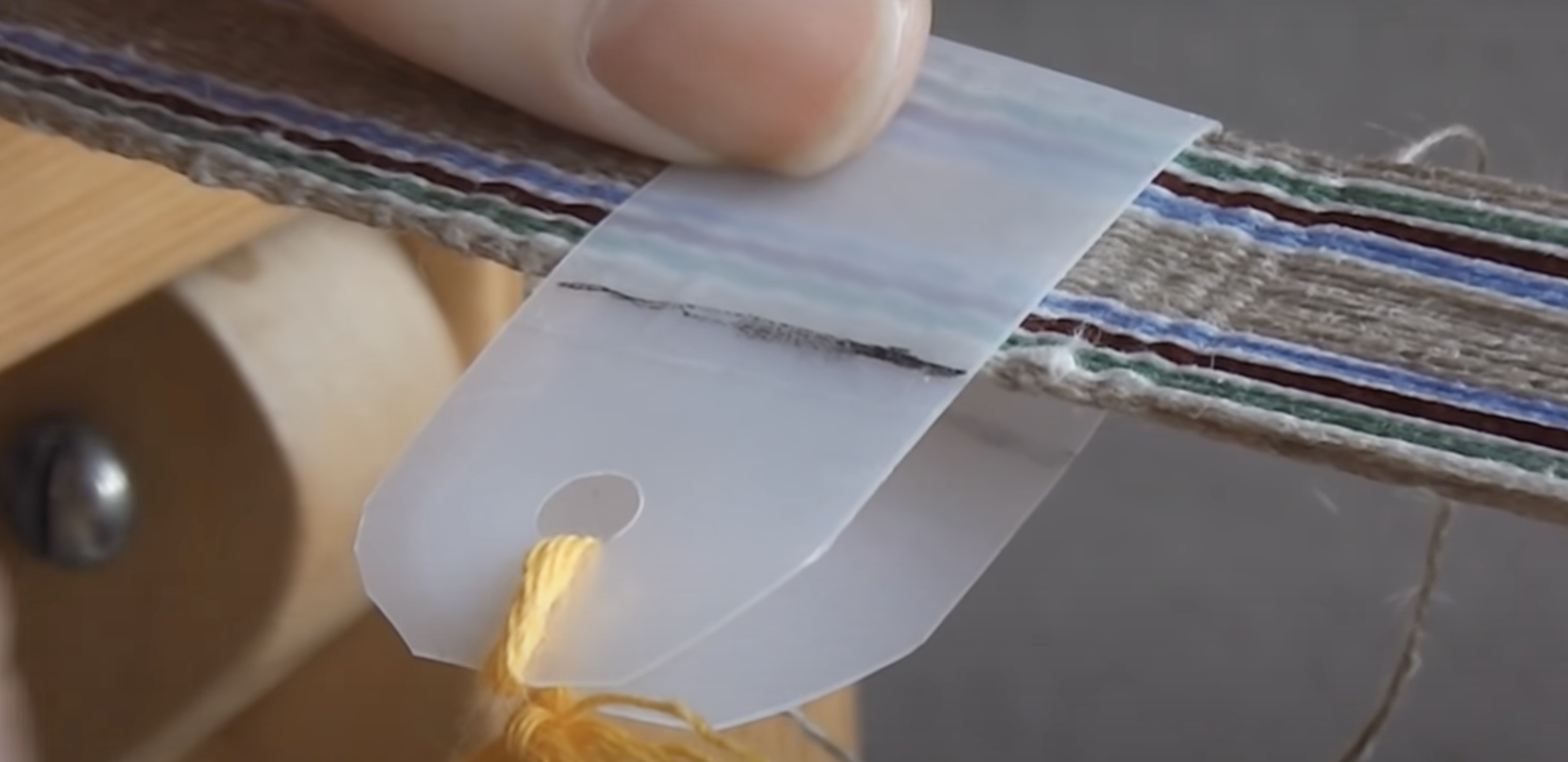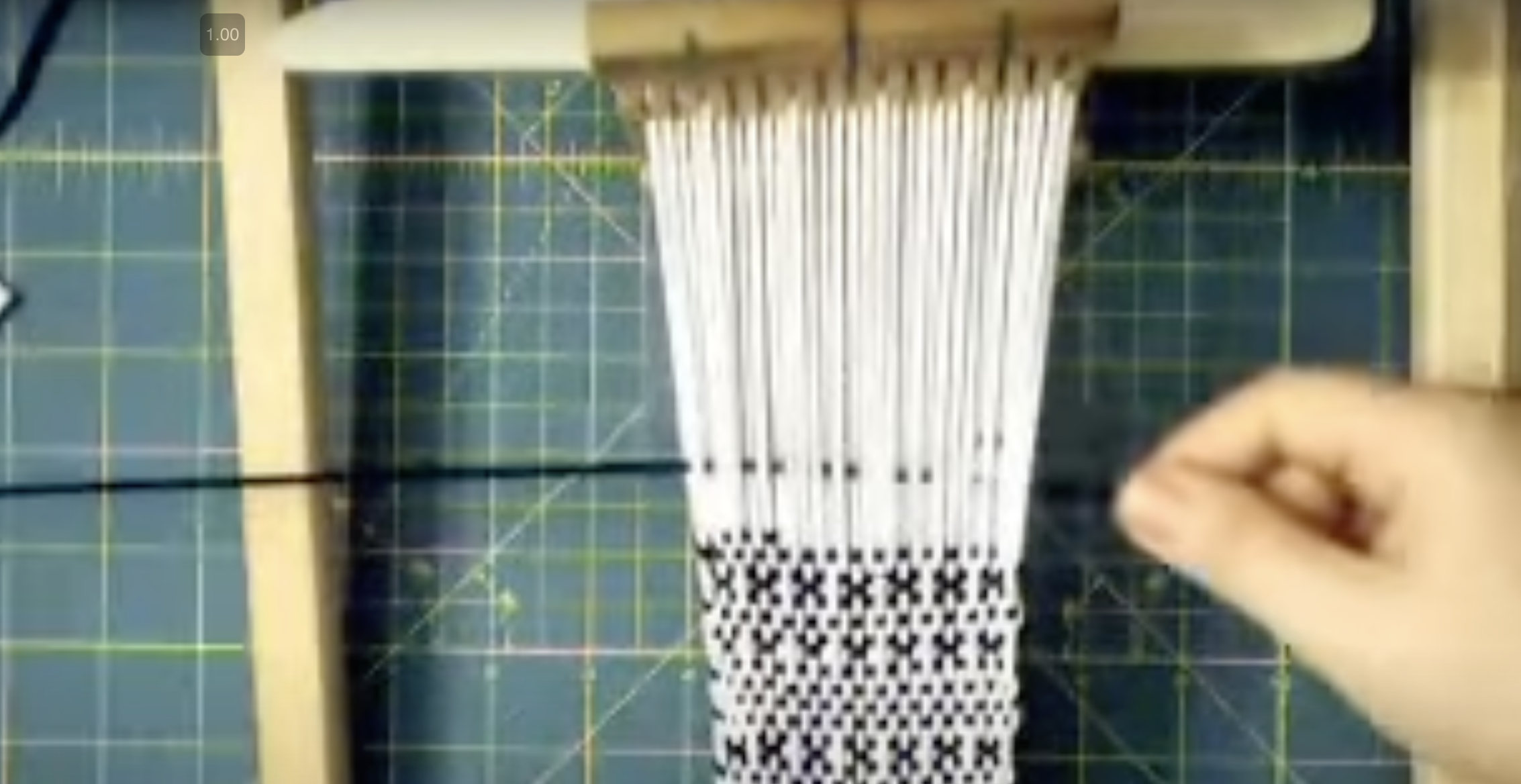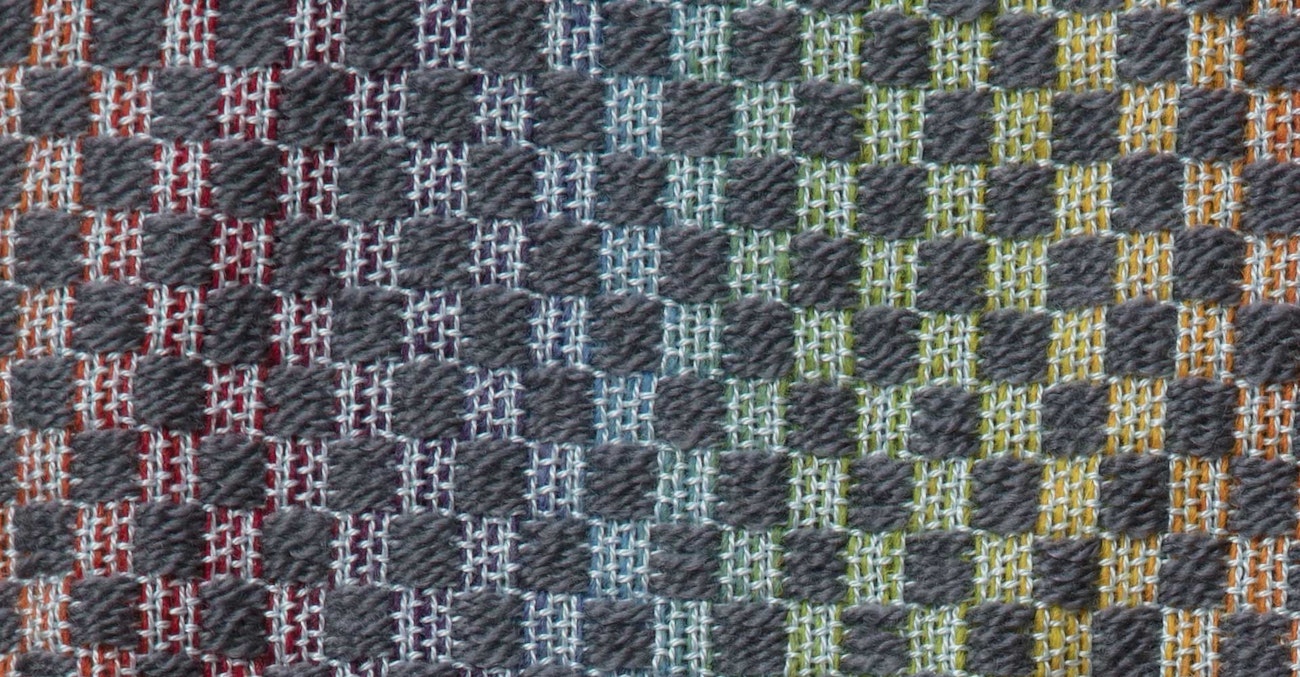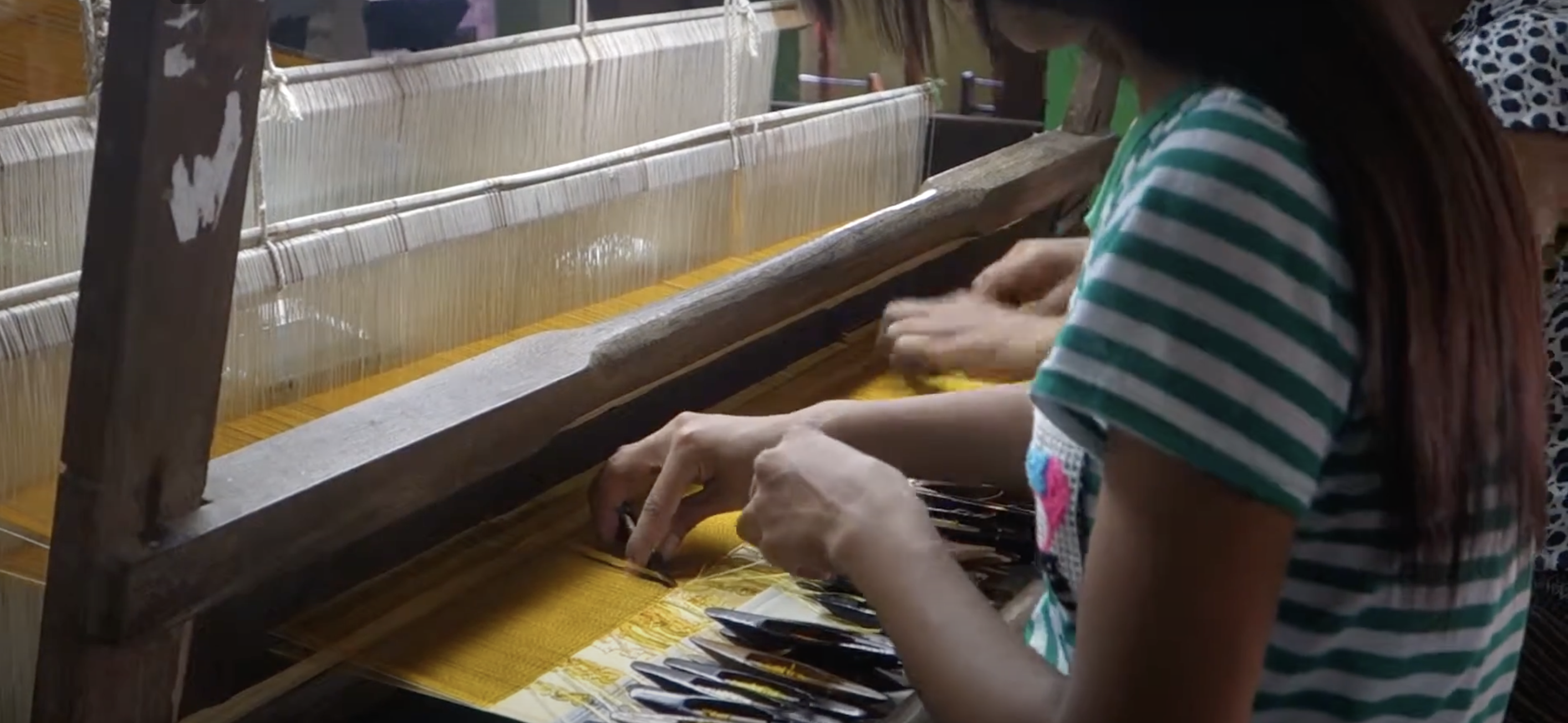Padonma Network
Handmade QR codes for globally tracking artisanal garments

Figure 1: An rMQR band, handwoven with a rigid heddle
Version: 2.4.0
Padonma Network
The Padonma Network is exploring the possibility of tracking cottage industry garments via handwoven QR codes. The goal is to design the easiest on-ramp imaginable by which a single artisan could make their products globally traceable via handmade QR codes.
The ancient handweaving technology of the rigid heddle loom seems like it may well be fit for the purpose of handweaving rMQR ID bands. Read the Bandgrind Experiments pages for a log of ongoing experiments into weaving rMQR ID bands via a rigid heddle.
This project is exploring the potential of tagging garments with handwoven labels containing rMQR codes, which are a variant of QR codes. The rMQR specification was ratified as an ISO standard in May of 2022. The name "rMQR code" is short for "rectangular Micro Quick Response code." Whereas original style QR codes are square, rMQR codes are narrow and rectangular, resembling ribbons:

There are many prior examples of handcrafted QR codes being recongized by QR reader software. The relative advantage of rMQR over QR in this project is that while handweaving it is easier to weave seven "bits" per row than the "wider" rows of traditional QR codes, and the machinery required to do so is minimal (fingerweaving would not even require a loom). The goal is to make it as easy as possible for artisans to join the Padonma Network.
It would seem like an rMQR code such as the one above could be woven into textile bands which would look something like the small band in the following example, but the black pattern "pixels" of the words would be replaced with rMQR code data modules:
A simple rigid heddle backstrap loom would be sufficient to weave such a band, which would look much like this exaple:
The weaving term "letter pick-up" refers to using pick-up techniques to weave letters into bands. So this Padonma Network project is trying to work out "QR code band pick-up weaving," or more succinctly "QR pick-up."
[This project was née "The Padumma Project" before being renamed "The Padonma Network." Currently this website is being migrated from padumma.com to padonma.net]
Table of Contents
Introduction
Bandweaving is an ancient weaving technology.
Completely separately, recording data in threads (interwoven and/or knotted) is also an ancient technology. For example the bean counters of the Incan empire went about their business using quipu, data recording devices fashioned from systems of knots on strings.
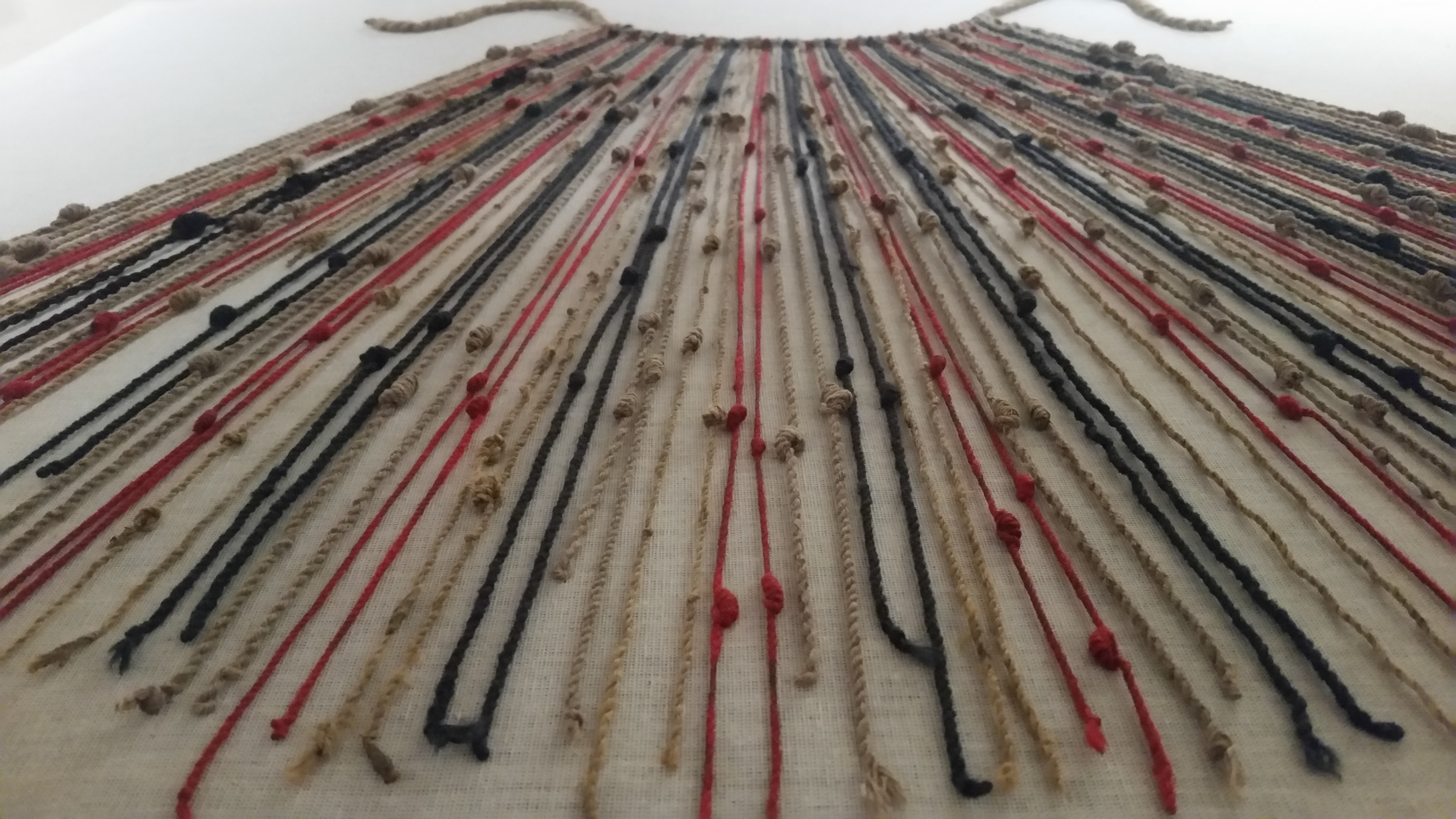
Figure 7: An Incan quipu
A bandweaving loom is about a simple as looms come, requiring only a small sheet of wood (called a rigid heddle as seen above) and thread, of course. In an extreme case, a rigid heddle loom could be constructed completely by hand, for example see How to Make Your Own Backstrap Loom. To weave a band, a rigid heddle backstrap loom is all that is required:
The above loom demonstrates that the barrier to entry to bandweaving is very low. More sophisticed looms enable producing bands faster at higher quality. For example there are task-specific stand alone tape looms where the heddle is integrated into a box frame loom:
Bandweaving can seemingly be easily adapted to pattern QR codes into small handwoven tags. In weaver's jargon, such tags are referred to by terms such as band, tape, ribbons, or more generally as narrow ware. In the Padonma Network, the term "band" has been selected, etymologically following the Sweeds, who use the word "bandgrinds" for rigid heddles, as in a bandgrind is a machine for grinding out bands.
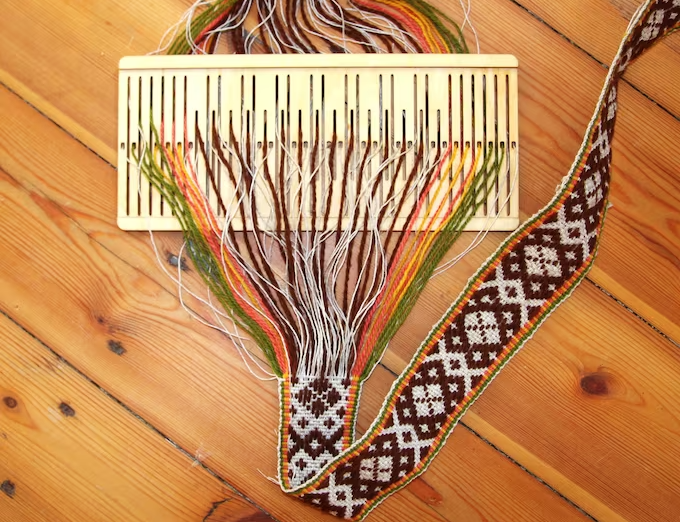
Figure 10: A band in a Sweedish bandgrind
Such ID tagged bands could be sewn into garments without disrupting the original design of a garment. Optionally an rMQR code code be added into the weave of a fabric using, for example, "supplimental weft" techniques. Once tagged such a garment could be digitally tracked through supply chains, yet an artisan would require no sophisticated computer control tooling, nor even power tooling, to join such a global economic market.
Each garment would have a unique QR code woven and/or sewn into it. Since each QR code would be unique to a specific garment, each garment would have a unique ID number assigned to it by its QR code. For the Padonma Network, the QR codes would just contain a UUID, a Universally Unique Idenfifiers. UUIDs are globally unique IDs that are 16 bytes of data in size. That is small yet a UUID is all that is needed for global digital inventory tracking. The smaller the data encoded, the quicker the tags can be handwoven.
The specific variant of QR pattern to be handwoven for Padomma is called an rMQR codes (etymologically, "rMQR" expands to r-M-QR, or "r"ectangular "M"icro "QR"). The rMQR standard, ISO/IEC 23941, was ratified in May of 2022. An rMQR ribbon that is seven or nine "pixels" wide is easier to weave by hand, when compared to "traditional" square QR codes which are 21x21 or 29x29 module ("pixels") in size. A R7x77 rMQR could encode a UUID, that is, could store 128 bits of data.
There are easy to use tools on the web that anyone can use to generate rMQRs, for example, Online rMQR Generator. For software developers, open source software source code is available to implement rMQR readers and writers that could work off-line in web pages: https://github.com/cozmo/jsQR
With simply these handwoven QR codes, handmade garments could be tracked globally throughout supply chains. In Padonma, the barrier to entry to join such a global supply system has been intentionally designed to be minimal, requiring only extremely minimal weaving machinery. A simple rigid heddle loom ( a piece of flat wood about the size of a flashcard) and thread in two colors is all the capital investment required, all of which could be manufactured by a single weaving artisan, from spinning thread to carving a heddle.
Proposal
This proposal has a hardware part and a software part.
The hardware part is the bands with UUIDs encoded into rMQR codes handwoven into them, which in the Padonma Network are called "rMQR ID bands." Each garment has a unique UUID encoded in the rMQR code on its ID band.
The software part is using a garment's unique UUID ID to represent the garment in the digital domain. The same (UUID) ID can be used consistently across both public and private databases. The same tag would be used in both context.
For an example of private database, artisans could track their inventory privately in a spreadsheet using the UUIDs. And when a garment leaves from its place of manufacture the same UUID will represent it outside in the wild. For an example of public database, a blockchain could be used solely as a public domain global inventory tracking system (not cryptocurrencies but garments will probably have NFTs that contain garment UUIDs), using the same UUIDs to represent garments globally.
Both parts of this proposal are addressed in the following subsections:
Handweave rMQR codes
We need to test this idea and actually weave some rMQR codes; see what can actually be scanned. For a primer on backstrap rigid heddle weaving see the below section, Bandweaving, an ancient minimalist weaving technology.
The rMQR spec defines some terminology:
A dark module is nominally a binary one and a light module is nominally a binary zero.
Each rMQR symbol shall be constructed of nominally square modules set out in a rectangular array.
In other words, the "pixels" in rMQR codes are called modules. The black ones are 1s. We want to weave modules that are nominally square enough to make a QR reader happy. The woven bands should be rectangular – consistent in width and straight enough.
To imagine what a handwoven rMQR band would look like, observe this weaver. The pattern he is weaving is rather similar to what a rMQR band would look like (a rMQR would just be black and white): Patterned band ~24 warps, backstrap, rigid heddle - YouTube:
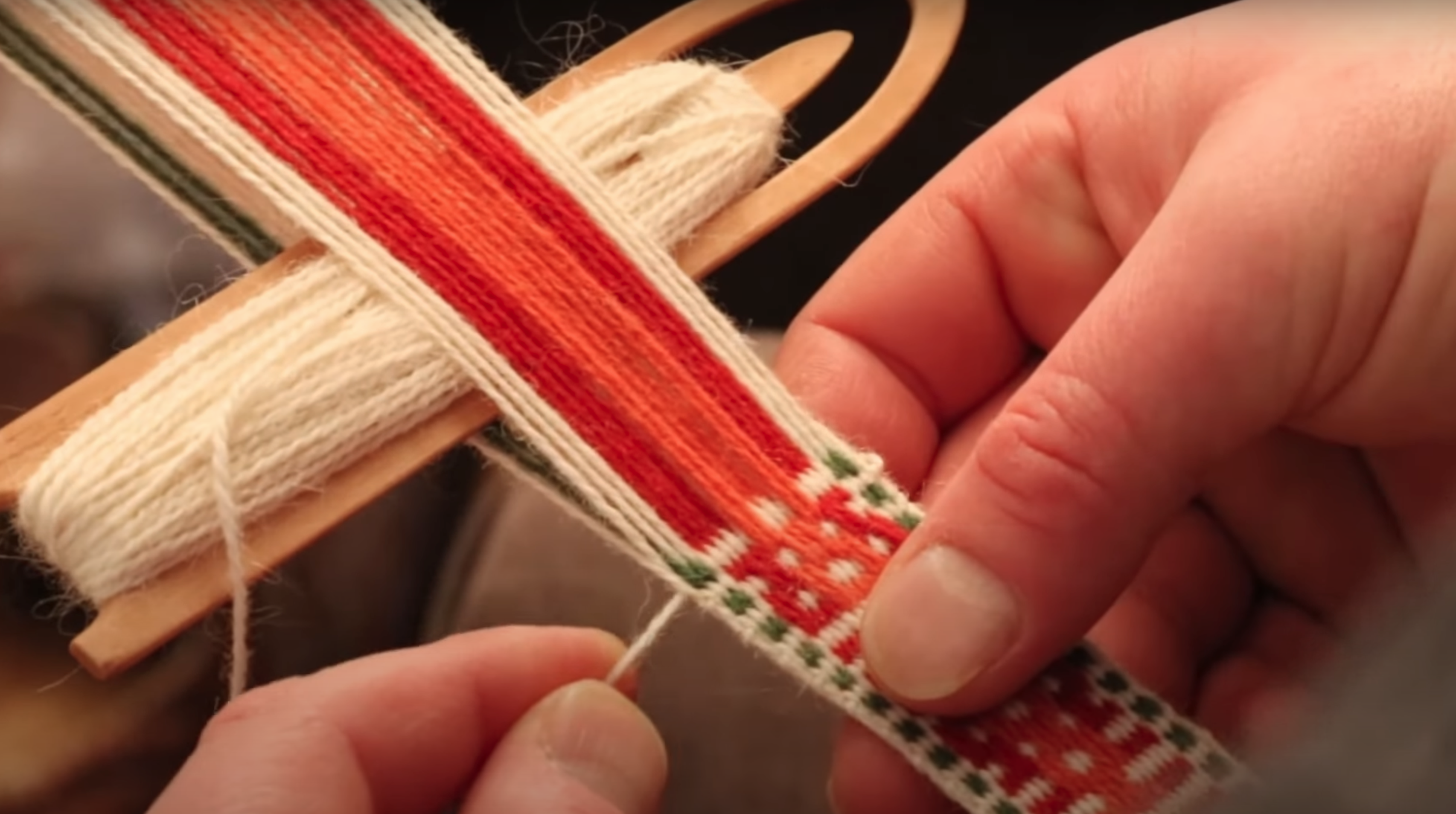
Figure 13: A potential rMQR band factory?
Weaving an R7-sized rMQR would be be simpler than as demonstrated in Pattern Weaving with Pick Up Stick Rigid Heddle Loom. As illustrated, the pick-up stick is how the weaver sets or resets a module in the rMQR.
The only tool needed to handweave the rMQR band is a simple small rigid heddle with 7 slot, and 8 holes. This is a very simple form of backstrap weaving. To weave an R7-sized rMQR code, the loom set-up would be as simple as in this video, Kedma Backstrap Loom, except the colors would be diferent: for weaving the rMQR codes the holes get white background threads and the slots get black pattern threads.
Note: the rMQR spec calls for a two module wide margin "quiet zone" all around the active data modules, which makes it easier for QR reader software to isolate a QR code from the image background. So a R7 rMQR with quite margin would require a warp wide enough to handle 11 data modules, although the four modules of margin (two on each end) do not need patterning controls in the heddle, as they will be always white background. This is starting to sound like a rMQR-specilized rigid heddle design: a 21 (3X7) pattern thread pick-up heddle with extra holes and slots on both ends for quiet zone margin threads. Pattern threads grouped in threes, three adjacent pattern threads for each QR data module. The following $35 bandgrind heddle would suffice, even if each QR data module requires three pattern threads (3x7 = 21 < 24):
According to a backstrap rigid heddle article in Spin Off it sounds like the pattern (black) and background (white) thread should be in a ratio 2:1 in diameter, and that S versus Z twisting might help the software recongize the rMQR code (or just do not use tablet weaving):
For pick-up patterns like I used here to create a red and white patterned band, the pattern threads (red) need to be at least twice as large as the background threads (white).
An interesting thing I’ve learned by band sleuthing in museum collections is that Norwegian bands often have a different twist direction in pattern versus background threads. Here, my red, 2-ply threads have a S-ply twist, and my white charkha-spun cotton threads are 2-ply with an Z-ply twist.
In the end, if their phone can scan the rMQR code, they've done it correctly and their garment would exist on the blockchain as an NFT with that same rMQR serving as the NFT image (with more info buried in the code and the NFTs metadata). The rMQR spec was ISO certified in May of 2022. There are already many QR reading apps which can read rMQR codes (but not default Android as of 2023; need to install free reader app).
Bonus: imagine displaying the rMQR on the weaver's phone as a weaving draft WYSIWYG assistant for rMQR weaving. Perhaps the phone could even be inserted into the loom while the pick-up stick is used. In order to create weaving drafts of rMQR, esxisting web apps could be used, such as Seizenn | loom pattern editor.
Existing loom pattern editing software can be used to layout rMQRs: Seizenn | loom pattern editor is a mobile app (packaged as a PWA). Such patterns could be shown on a phone, and the phone shoved into a small rigid heddle loom as a visual guide to the rMQR to be woven.
It may well be that a more complex type of rigid heddle called a "pattern heddle" may make the weaving easier. A pattern heddle, or pick-up heddle, has both short and long slots, which makes picking up only pattern threads easier (so faster rMQRs?). Notice that the heddle shown below has only long slots on both outer ends, which is how "two modules" of pure white selvedge would be woven, as called for in the rMQR spec:
See, Bandweaving on Jumaka.com, for valuable heddle designs such as double holed and double slotted (DIY lazer cut out of wood), and pointed tip heddles which makes pick-ups of threads eaiser (for faster rMQR weaving).
And there may well be other pickup weave techniques the could adapted for high-speed rMQR codes weaving. For example, How to Weave Pickup on a Band Loom.
Tablet weaving might also be a quick process. For example, Double faced tablet weaving - YouTube. Tablet weaving by nature has a diagonal orientation to the warp threads. QR modules woven via tablet weaving might be harder for QR readers to recognise. Although in Tablet Weaving a QR code | BushcraftUK Community, there is a tablet woven QR that surprising does scan:
For the situation where the artisan already has a large loom and wishes to encorporate an rMQR into the garment but not as a tag, an rMWR codes could be added into the loom as a separate layer via a "supplemental warp" as illustrated in, Rigid Heddle loom - Weaving a Supplemental Warp - YouTube.
Track garment rMQRs on a blockchain
QR codes can encode any arbitrary digital data. In the use case of Padonma, the QR code will encode the unique digitial ID of the garment into which it is sewn. For Padonma, the digital ID data standard used is called UUIDs, short for Universally Unique Idenfifiers. The garment IDs can be tracked in a distribute inventory system, which for the Padonma project would be implemented using blockchain technology.
In other words, the handspun QR code encodes the ID of the garment's unique NFT. The NFT is simply the unique ID of the garment in the distributed global inventory tracking system, which happens to be a blockchain. (There are no overpriced JPEGs in this blockchain use case.) This is how a handcrafted garment can be tracked in a global inventory system as the garment travels the global supply chain.
A garment's physical tag will have its QR code handwoven into the fabric, using simple techniques to make what weavers call bands (or narrow wares, or ribbons). The encoded IDs correspond to NFT IDs, each garment has its own NFT. The NFT is simply for inventory tracking identity, think of it like a digital passport for the garment. This is not a silly collectors game based on overpriced JPEGs. The NFT gives the garment an identity in the distributed database that is the blockchain, which serves as the inventory tracking system.
Each garment will have its own unique rMQR tag and own unique NFT. A collection of such NFTs tracked on a blockchain are the distributed equivalent for a factory inventory system that could span the entire supply chain.
Background topics
rMQR codes are band shaped QR codes

Figure 19: The above is the rMQR Code for "https://padumma.com"
Critical to this proposal is the relatively new QR variant, rMQR, which became an ISO standard in May of 2022. An apropos analogy would be: square is to rectangle as QR is to rMQR. It seems like these rMQR codes would be easier to handweave than the original large square QR codes.
In May of 2022, ISO standardized a new QR code variant. Standard ISO/IEC 23941 defines this new type of QR code, called rMQR codes. They are designed to be narrow (7 to 17 "modules" wide), and come in various lengths as needed to address data storage requirements.
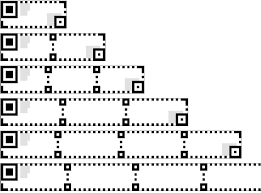
Figure 20: Six blank rMQR codes of various sizes
An R7-sized rMQR is – as the name implies – 7 modules wide. Here is what an example R7x77 rMQR looks like. This is large enough to encode a UUID, which would be a very useful garment ID by which Padonma could track garments in a distributed inventory system. (Note the rMQR spec calls for two a two module wide margin quiet zone around an rMQR Code, so the white background margin below is technically part of the rMQR Code. More importantly, a R7-sized rMQR would require an 11 module wide band to be handwoven.)

Figure 21: An example rMQR, of size R7 x 77, long enough to contain a UUID
All Universally Unique Idenfifiers (UUIDs) are 128 bits long or, in other words, 16 bytes in size. According to ISO 23941, an rMQR Code of size R7x77 at error correction level "M" can handle 160 bits (or 19 bytes max). Or an R9x77 (error correction "H") can also handle exactly 16 bytes of data.
For Padonma, the QR code will contain a UUID that IDs the garment. For example, one of those UUIDs might look like the following:
170bf486-a96f-47e9-90e6-632373d27924
- Demo create rMQR codes: Online rMQR Generator
- Tech primers
- rMQR Code | QRcode.com | DENSO WAVE
- Standardization 05.2022 Obtained ISO approval
- What is rMQR Code?|Technical Information of automatic identification|DENSO WAVE
- DENSO WAVE Develops “rMQR Code”, a new rectangular QR Code that can even be printed in long, narrow spaces.
Capacity
a standard QR code can hold up to 7,089 numerical digits or 4,296 English letters. A Micro QR code can only contain up to 35 numbers or 21 letters, but a rMQR code ups it to 361 numbers or 219 letters with only a slight increase in size over the Micro QR code. (via QR codes evolve into their newest form: a bar QR code - Japan Today)
- rMQR Code | QRcode.com | DENSO WAVE
- The spec
- ISO/IEC 23941
- First edition: 2022-05
- ISO/IEC 23941:2022 — Rectangular Micro QR Code (rMQR) bar code symbology specification
- 2020, was draft ISO standard: (24) Rectangular Micro QR Code | LinkedIn
- ISO/IEC 23941
Handicrafted QR codes
In, A Spinner’s Journey in Inkle Bands, author Jeannine Glaves descibes how she wove regular square QR codes and then went on to embed text into bands she wove.
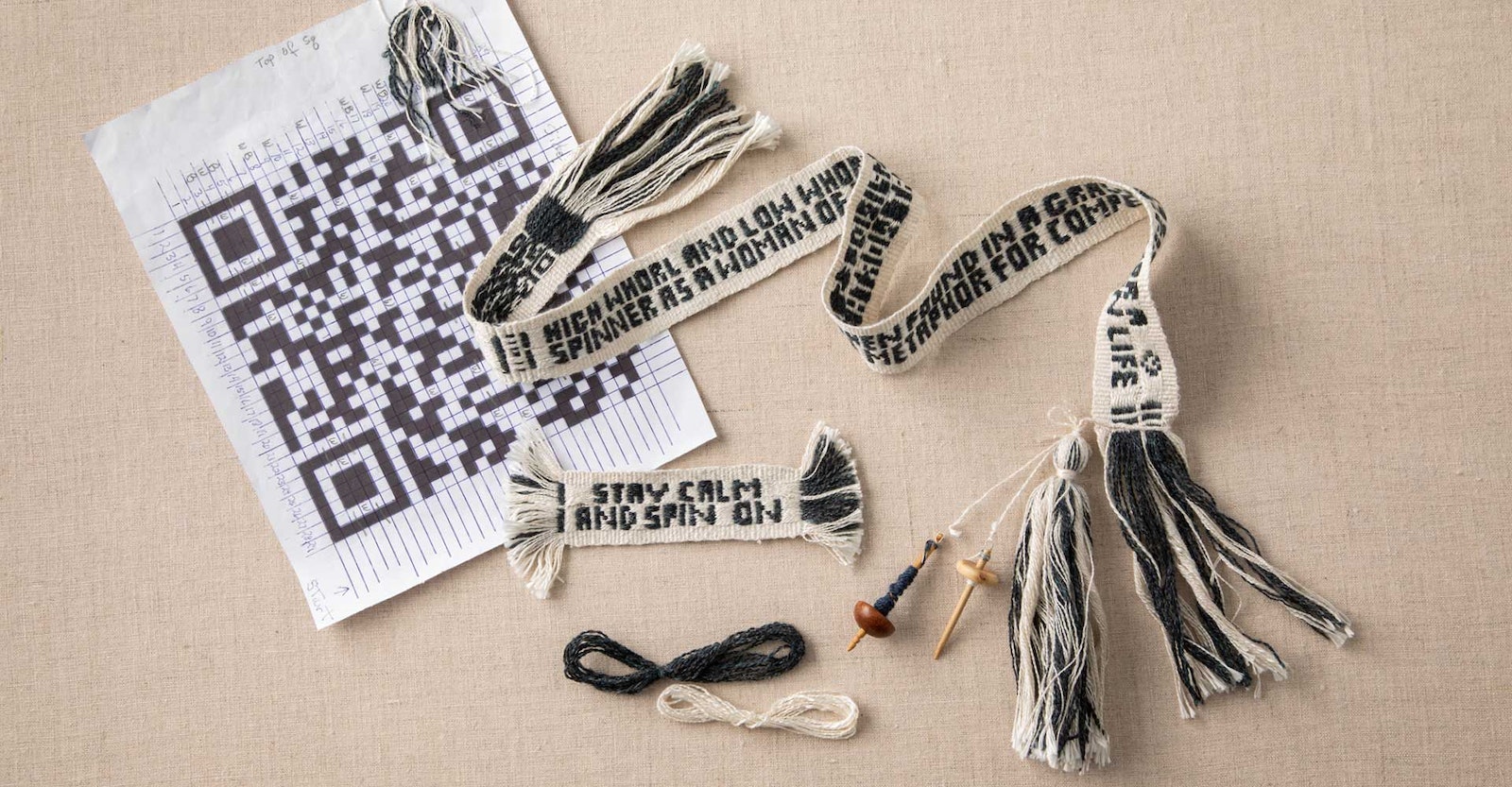
Figure 22: Notice the draft pattern for a square QR code in the background
Note she uses the term "letter pick-up" so perhaps this Padonma project is trying to work out "QR code band pick-up" or just "QR pick-up." It would seem that her work could be extended to weave rMQR codes into bands, which could then be sewn into garments.
Note also that is sounds like she was able to get a QR reader to work using only a single stitch per QR module. Perhaps a rMQR reader will be able to work with that resolution.
While homebound during COVID-19, I looked for something new to try with the bands. I thought it would be fun to weave my vaccination QR code. The code pattern needed 29 pairs of warp threads. A pattern pair consists of a light background and a dark, heavier pattern thread. Since the QR code would be square, it would take only 29 pattern wefts to weave the code
In Why, yes… yes I did! Weaving QR code, we see an example of 3 warps per QR data module:
- Examples of handicrafted QRs
- On Etsy, one stitched QR patch The Original Never Gonna Give You Up QR Code Patch
- A gallery of QRs all handmade: woven, knitted, croceted | QR-3D
- A gallery of "woven" QR codes on various objects large and small
India uses QR codes to ID artisanal handloom goods
QR codes are already being used to track all manner of handicraft products. For example handmade carpets: QR Codes Seen as Key to Reviving the Fading Glory of Kashmiri Carpets. The closest prior art to Padonma is what the Indian government is doing with woven products. The following articles serve to illustrate the goings on in India.
NEHHDC-textiles department collab to encompass over 10,000 looms (2023-10)
In alignment with this initiative, NEHHDC, in collaboration with the Department of Textiles, aims to adopt an additional 500 weavers in Meghalaya, with a particular focus on the Silk Village.
Banarasi Saree To Have QR Code Woven In, IT-BHU Develops New Technique to Identity Genuineness of the Handloom Products | LatestLY (LatestLY, 2019-07)
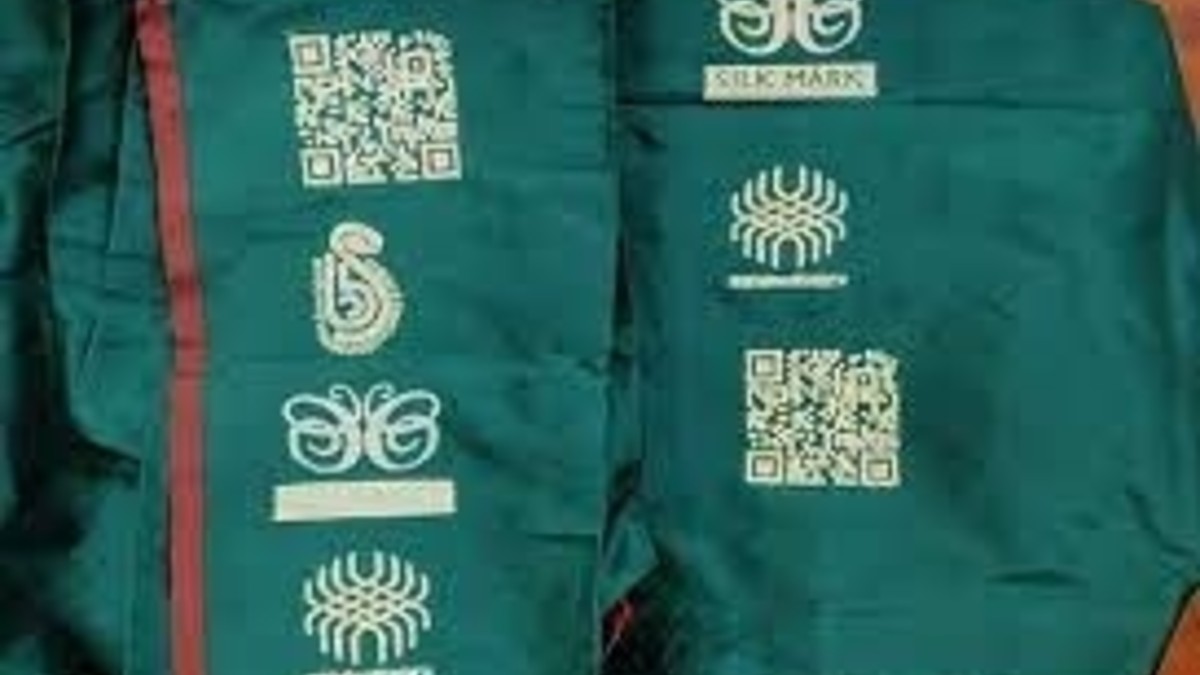
The manufacturer can weave the QR code on saree with details of his own firm and manufacturing. Whenever customers want to know about a product, he has to use the scanner in his mobile to know about it. He will get all details entered in the QR code, like place of the manufacturer, date of manufacture, etc. These measures will create confidence in customers and increase sales.
Research scholar M. Krishna Prasanna Naik, who is working on the growth of the Banaras handloom industry, said that the Banaras handloom industry is facing major issues, with MARKETING being one of them.
According to his study, most customers are not aware of the difference between handloom and power-loom made saree. Only a limited number of customers know about the handloom mark and GI mark.
His study also shows that customers are unaware of whether sellers provide real handloom marks or duplicate handloom marks with products. So, he came up with the idea of sarees having logos and QR code.
Naik said that the fully designed saree consists of 6.50 meters in length in which 1-meter blouse pieces are included. After the sari part is completed, a part of 6-7 inches of plain fabric before the blouse is weaved. This patch contains the QR code and the other three logos.
Incorporating these logos in this extra fabric piece, will not reduce the fabric strength and style and the looks of the saree will remain intact. Amresh Kushwaha, chairman, Angika co-operative society and Angika, a Varanasi based designer, have implemented the idea for the first time.
Handloom: Now, Qr Codes In Fabric To Carry Info On Ne’s Handloom Products | Times of India (2023-10)
Blockchain and the luxury fashion industry
- Review article, 20 February 2023
- School of Fashion and Textiles, Australia
Abstract
..This review highlights the opportunities that exist in adapting Blockchain Technology in the fashion and textile supply chain, while also providing insight into the challenges of adopting this technology. This paper provides a systematic review of the potential of Blockchain Technology within the fashion and textile industry’s supply chain to analyse its role in traceability, transparency, and product authenticity. To achieve this, a substantive number of research papers and non-scholarly resources have been scrutinised. ..
Blockchain In Fashion: Is It Ready? - The Interline
- 2022-03
Quotes
Marjorie Hernandez, founder of LUKSO champions blockchain technology as the best solution to enhance flexibility, transparency and agility in supply chain operations.
When it comes to those experimenting with blockchain technology, one of the first early adopters was a collaboration between Danish fashion designer Martine Jarlgaard and blockchain technology provider, Provenance.
Blockchain: Unlocking Transparency And Traceability In The Fashion Supply Chain - The Interline
How Blockchain Technology is Transforming the Fashion Industry?
Blockchain technology makes it convenient to track royalty payments. It doesn’t just allow the designers to develop an unchangeable proof of creation but it can also be used for creating and tracking trademarks, license designs in addition to royalty programs or sales originating through these designs.
How digital fashion, the metaverse, and NFTs could change the fashion industry - Vox
Lotus thread industry research reports
Over the last decade or so, there have been multiple parties who have studied the economics around lotus silk, in Burma and beyond. Listed here are various studies of lotus silk. The first one is the most germane and gets down to wages for various jobs, identifying where value is added:
- Lotus Fiber Value Chain in Myanmar (PDF)
- Study on Lotus Fiber Production in Sunn Ye Inn, Sintgaing Township (PDF)
- Dynamics of Weaving Industries in Amarapura Township, Mandalay Region
- 2019 article in International Journal of Business Anthropology
- On the web: https://articlegateway.com/index.php/IJBA/article/view/1403
- PDF cached on this site: cached/documents/weaving_industry_dynamics.pdf
- Author: Win Win Soe, University of Mandalay
- DOI: https://doi.org/10.33423/ijba.v8i2.1403
- Techniques of Weaving Silk from Self-Woven Silkworms and Lotus Thread of Artisan Phan Thi Thuan in Phung Xa Craft Village, My Duc district, Ha Noi, Vietnam (PDF)
Bandweaving, an ancient minimalist weaving technology
Rigid heddle looms can be purchased for less than $10 on the web.
The 15-string heddle on the left has seven slots for the pattern threads, & eight for the background threads i.e. a 15-string heddle should be sufficient for a R7-sized rMQR band.
Kedma's smallest rigid heddle, a 15-thread rigid heddle, could probably do an R7-sized rMQR: 8 holes (background) and 7 slots (black foreground)
Clearly arbitrary patterns can be manually encoded with simply two pick-up sticks on a rigid heddle loom. One thing that needs to be figured out is if a single thread can serve as a data module in a rMQR. Here we see two thread being used in a repeating 11001100 pattern.
Testing will need to be done on weave patterns, thread thickness (pattern versus background threads, 2:1?), spin direction, et cetera to find the minimum that makes a phone camera happy to read a handwoven rMQR.
Alternatively, the above could be interpreted as 1010, where each two threads is a single data module? Would it be safer if a data module were two threads wide and two wefts tall, which is known as basket weave:
- Bandweaving QR module squares
To weave a single QR code module (i.e., bit or pixel), three same-color adjacent stitches in a weft row seems to look like a square, at least enough for a QR reader to play along.
So then, since a QR module is the same thing as a bit, the following band could be read as encoding a list of 7-bit binary numbers. Each weft row can be seen as a seven bit binary number, each three adjacent weft threads a bit of that row's number. (Ignore the fact that the yellow margins would be white if the rMQR spec were to have its way.) In the list shown below, the elements are alternating rows of all 1s and then all 0s, except the 0s rows each has a single 1-bit on (the green diagonal).
As for how long it should take a practiced weaver to create an R7x77? About 15 minutes.
A human can hand encode individual bits on a single stitch, but can QR reader applications handle that? Probably not in this case:
It sure looks like three stitches will be sufficient to render a single QR data module. Might two work? Maybe. Need to run tests.
For another example of weaving square-ish modules, observe in the following image that in the horizontal lines of the Ns that the "pixels" are three warp wide. Also note that the font is five "pixels" tall, so the band is essentially the size of an R11 wide rMQR with the required two "pixel" quiet zone white margin around the code:
People already weave letters into bands ("letter pick-up"). For example, Weaving Letters on an Inkle Band - YouTube. So, somewhere between those two extremes of "print resolution" (single stitch versus block letters that OCR could read) is where a QR code reader will fail to read a code.
For QR codes weaving, black and white thread will work (although any pair of contrasting colors would work, testable by photographing in black and white). Only needing two colors of thread is nice and minimal in terms of sourcing and stocking supplies.
With pattern weaving, the default is that the pattern warps are doubled threaded (two warp threads in a hole or slot), compared to the background colored warp threads which are single threaded. Seemingly a ratio of 2:1 for pattern to background is suggested. Some experimentation has to be done to find the ideal ratio for weaving QR modules. In pattern weaving the pattern (i.e. the visual foreground) is more important than the background, for appreciation by humans. But for QR codes the foreground (black) and background (white) are both equally important, for "appreciation" by QR code readers. Thread ratios will also affect background coloring showing between on-pattern QR modules. For example the background shows through in the following band (note that in this example, dark is the background color). Surely QR readers can handle some inter-module border&margin coloring. Dunno.
A simple band width guide might help make rMQRs that are easier for a smart camera to read:
Additionally, there is a serendipitous overlap with the nature of band weaving and the rMWR spec. The outer side edges of all rMQRs are dashed on/off black/white, as per the spec. This is a timing feature intended to make alignment easier for the QR code reader software. The spec says, "alternating sequence of dark and light modules enabling module coordinates in the symbol to be determined." So, if a weaver is inconsistent with how tightly the weft is beated down or narrow the band is made, the timing dashed pattern will help correct for abberations.
- Some close examples.
Pattern Weaving with Pick Up Stick Rigid Heddle Loom - YouTube: pick up stick is the manual programming part of the weaving processs
From earlier, on YouTube a guy banding like a rMQR with a rigid heddle, ~9 pattern modules:
Seemingly 8-by-8 modules would work well. But 8-by-8 seems like overkill in terms of return on investment. That is, one of the goals herein is to find out the minimum amount of work to get a QR reader to recognize a handwoven rMQR code. (Of course, if someone wants to have a larger than minimally required rMQR that might be an intentional part of the look. For example, perhaps someone would like to have a band all along the bottom of a skirt, where only a section contains a rMQR – go for it.)
- Primers
- Narrow Band Weaving
- Bandweaving Using Rigid Heddles and Inkle Looms eBook | Spin Off Library
- Free ebook of instructional articles
- "we’ve collected seven of our favorite bandweaving articles and projects together"
- Backstrap Rigid Heddle Basics: Start Weaving Handspun Bands - YouTube
- mentions pickup bands
- How to use pick up sticks - YouTube
Weaving techniques in Burma
Near Mandalay in Burma, they weave silkworm silk on looms and hand pick patters, on the loom. Certainly they could hand-pick a rMQR code but separate band tag seems simpler. But, either way would probably work.
Manual pattern picking Weaving a longyi at a shop near Mandalay - YouTube. Sounds slow: they supposedly weave an inch a day!

Figure 43: Via Silk weaving in Amarapura, a small town near Mandalay

Figure 44: Silk patterning, extremely manual
Conclusion
The current goal is simply to prove that handwoven rMQR codes can be easily scanned by mobile phone. Weaving experiments are currently being done to figure out the cheapest, easiest, and quickest way to handweave rMQR bands.
Once a garment is tagged with an rMQR band with a unique UUID encoded in its QR code, all manner of interesting things can be done. The rMQR band tags the garment with a unique UUID, and that UUID is the garment's unique identity in the digital world.
"Rem QR ID band"
blockchains using rMQR tags.
As an example of one manner of interesting thing to do with * rMQR ID bands*, the Padonma Network project hopes to explore globally tracking garments via distributed web technnologies.
Perhaps web5 might be an elegant solution – something involving blockchain for public info, and artisans storing their private data in DWNs web5 DWNs data packbacks).
And the UUID in the rMQR ID band it what connects the garment's identity in the public web, the blockchain, and the DWN private database.
Once inventory is on a blockchain, paying for garments with, say, Bitcoin is certainly possible. Surely it should be possible to pay for a garment by exchanging Bitcoin for a garment NFT. (Via web5?)
In India, the government already encourages paying for QR coded handloom objects via digital money: QR Codes in Handloom and Handicraft Industry: Make It More Vibrant:
Also, The Ministry of Textiles, Government of India, promotes digital transactions using BHIM app or Bharat QR Code. Bharat QR Code is one of the most popular QR Code-based mobile banking apps in India.
But the Padonma Network should use an open source blockchain to be run publicly by artisans on their Android phones. And the only actually valuable cryptocurrency is Bitcoin so, web5? (What does a decentralized, blockchain-related, network-of-trust based global inventory system working in a networkless jungle look like? A blockchain network that keeps falling apart yet somehow comes to consensus? Each (Android) node would run its own web5 inventory app? Et cetera.)
